December 23, 2022
Part 5: Aftermath (The morning of June 4 onwards)
June 4, 1989, 6:00am – Morning commuter is greeted by an army at south end of Tiananmen Square.
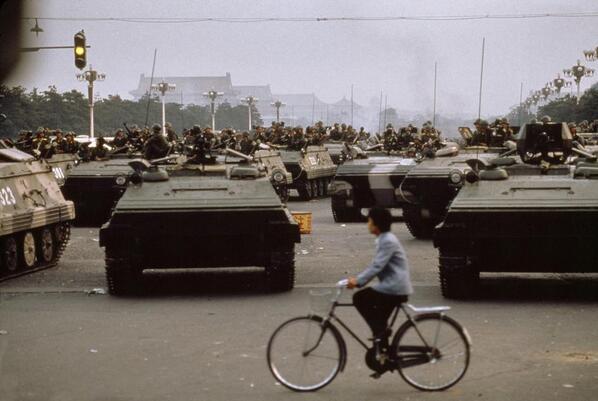
June 4, 1989, 6:00am – Local residents in western Beijing commute through a still-burning war zone.
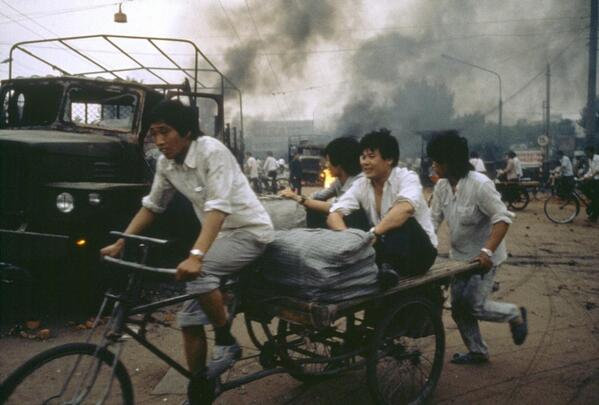
June 4, 1989, 6:00am – Beijing residents show spent bullet casings from battle the night before.
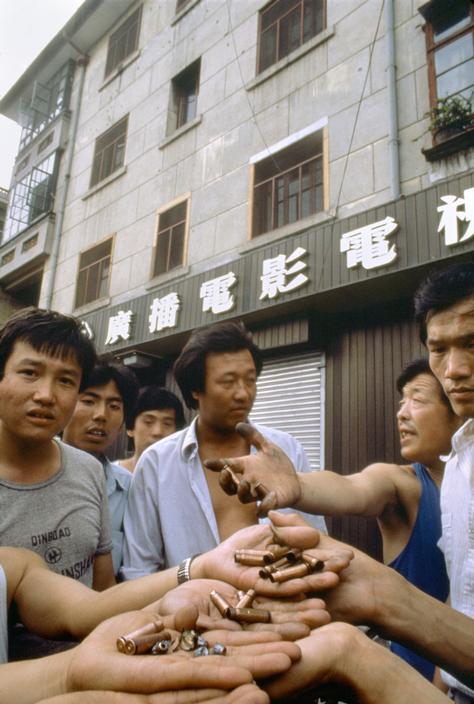
June 4, 1989, 6:30am – Beijing residents stand watch over dejected soldiers on overpass. Note covered bodies.
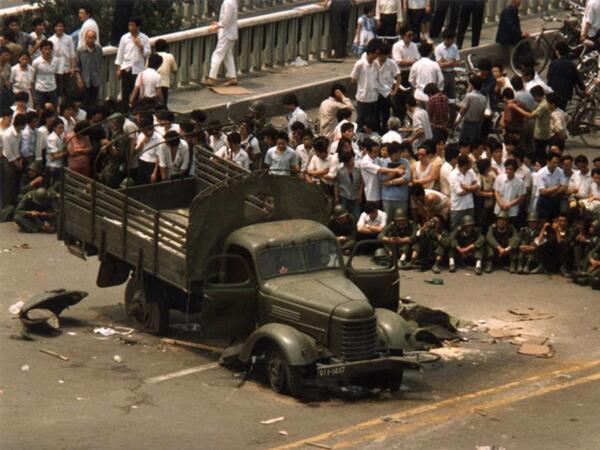
June 4, 1989, 7:30am – 28th Army column of reinforcements moving into Beijing is blocked, harassed at Muxidi.
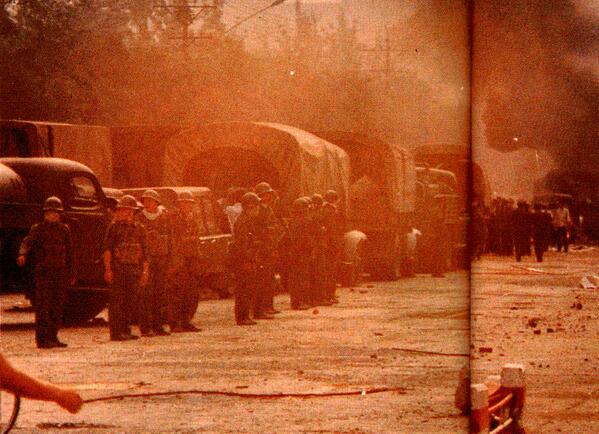
June 4, 1989, 8:00am – Beijing residents redeploy burned-out buses to build new barricades along West Chang’an Ave.
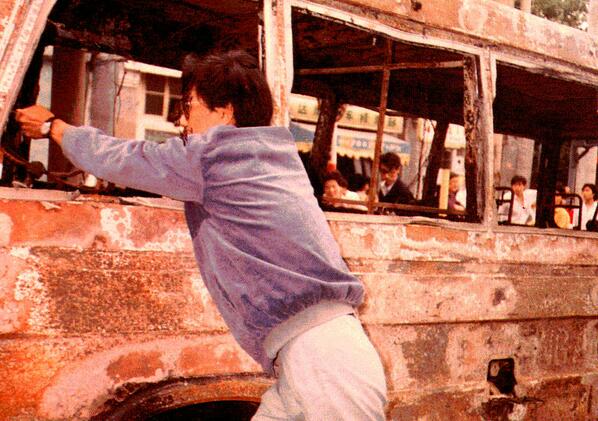
June 4, 1989, 8:00am – Burned out army truck on Chang’an Ave looking west, in front of Zhongnanhai leaders’ compound.
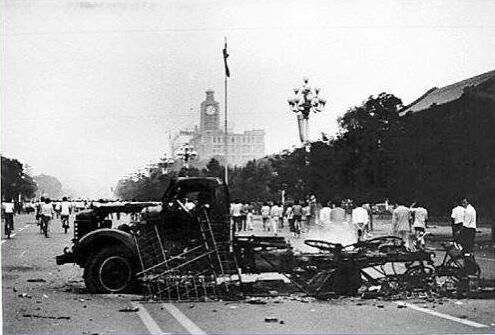
June 4, 1989, 8:30am – Tanks take up position amid destruction at Beijing intersection.
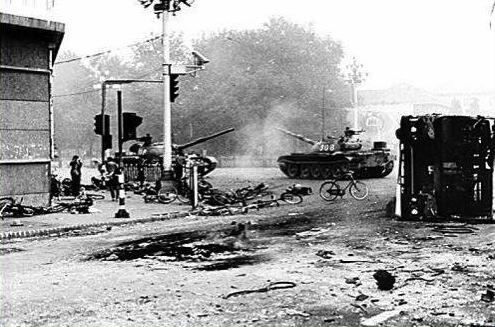
June 4, 1989, 9:00am – Beijing residents show bullet that came through their apartment window.
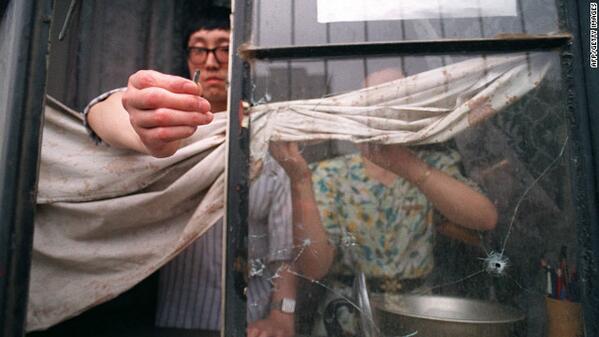
June 4, 1989, 9:00am – Troops begin cleaning up piles of tents, belongings, trash left behind in Tiananmen Square.
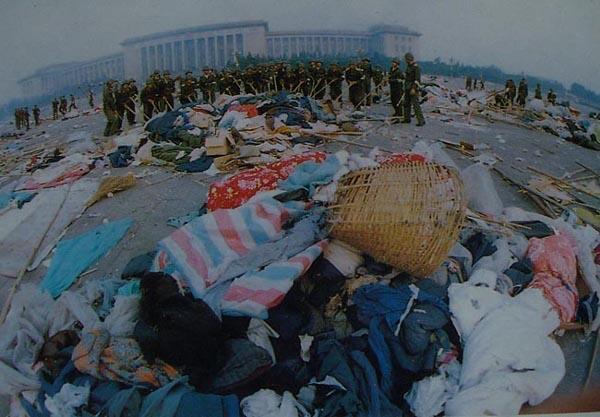
June 4, 1989, 9:00am – Bonfires lit by troops in Tiananmen Square quickly consume memories of student protest.
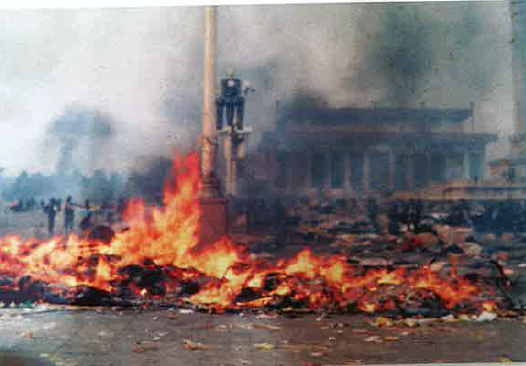
June 4, 1989, 9:00am – Soldiers lose no time in destroying any remnant of student protests in Tiananmen Square.
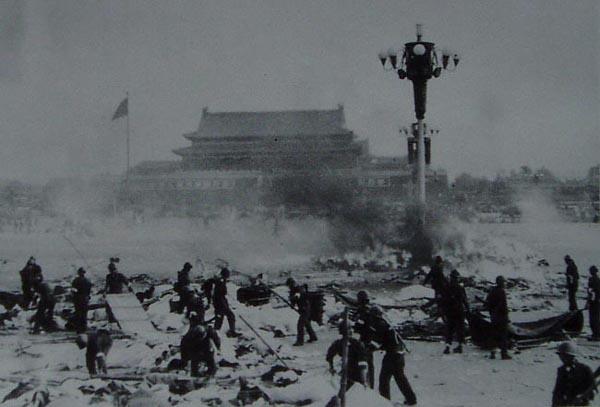
June 4, 1989, 9:30am – Beijing residents explore wreckage from previous night’s battle at Muxidi.
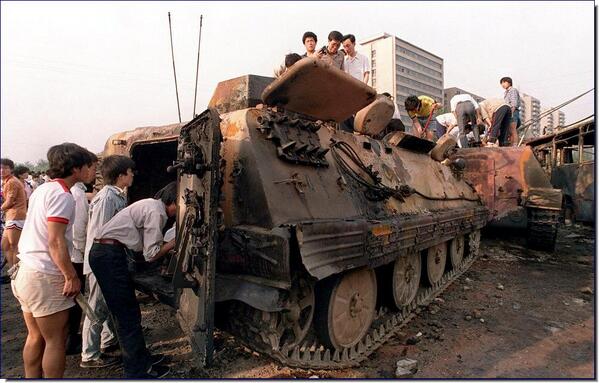
June 4, 1989, 9:30am – Man passes burning jeep at Beijing intersection, legacy of previous night’s street battles.
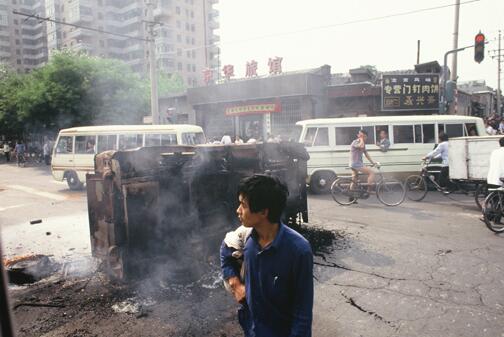
June 4, 1989 – The crackdown in Beijing provoked demonstrations that day in 63 cities across China. Most were relatively peaceful.
June 4, 1989, 10:00am – Police in Chengdu deploy tear gas to disrupt student march in People’s Square.
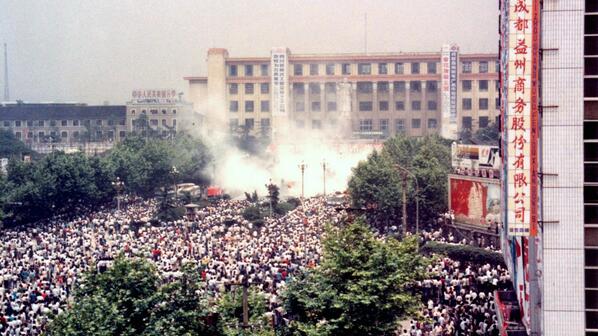
June 4, 1989, 10:00am – Students throw rocks at police cordon in Chengdu’s People’s Square.
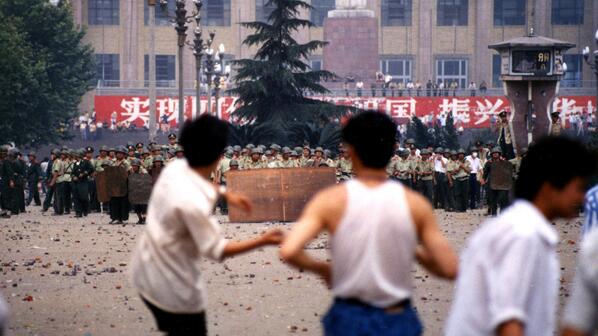
June 4, 1989, 10:00am – Police charge protesters in Chengdu’s People’s Square, beating them with electric prods.

June 4, 1989, 10:00am – Protesters in Beijing set ambulance on fire and drive it at the line of soldiers guarding Tiananmen.
June 4, 1989, 10:00am – Blazing ambulance hits traffic island in Chang’an Ave and fails to reach its target.
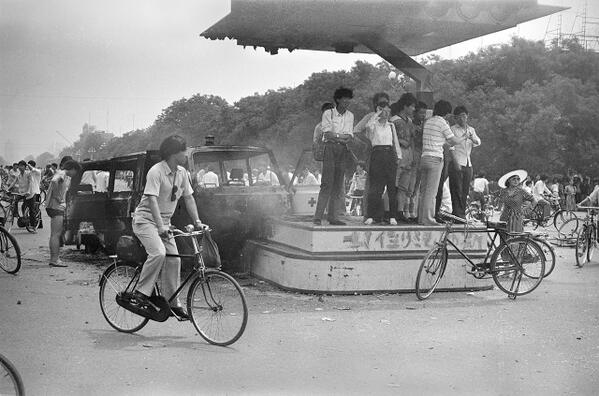
June 4, 1989 – Students in Lanzhou, Wuhan, & Changsha did disrupt traffic on major railway lines by lying their bodies across the tracks.
June 4, 1989 – New York Times: President Bush assails shootings in China.
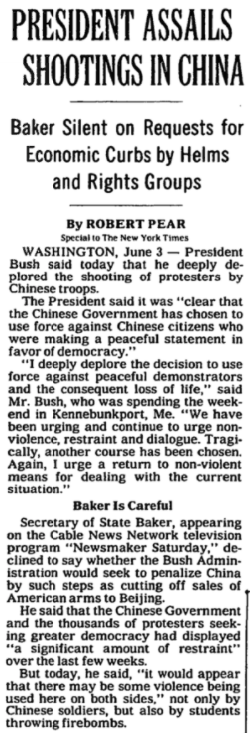
June 4, 1989, 10:00am – Line of soldiers about to open fire on crowds gathered near northeast entrance to Tiananmen Square.
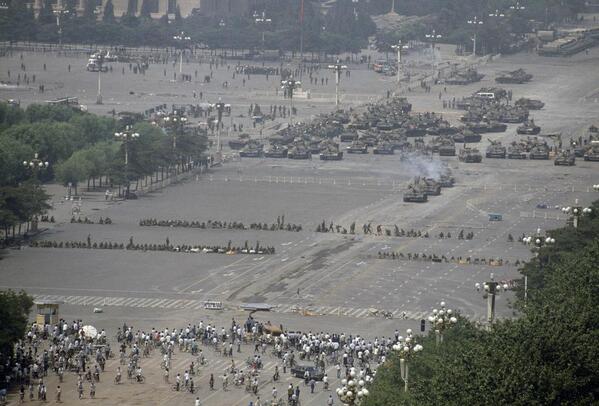
June 4, 1989, 10:15am – Soldiers firing on crowds at northeast corner of Tiananmen.
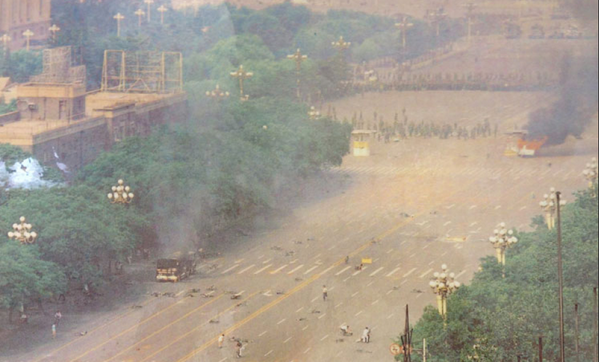
June 4, 1989, 10:15am – People flee machine-gun fire along Chang’an Ave, in front of Beijing Hotel.
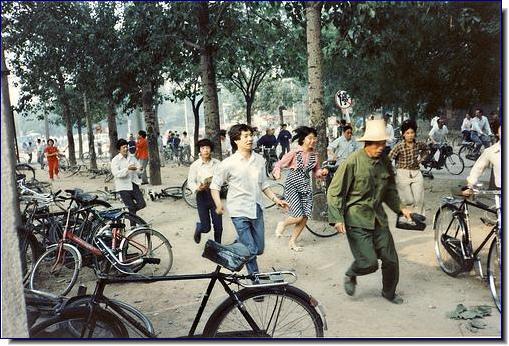
June 4, 1989, 10:15am – Steady stream of new wounded are rushed to hospital in Beijing.
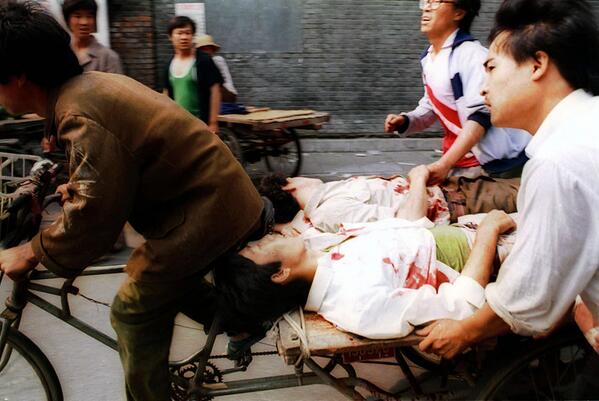
June 4, 1989, 10:15am – Man injured in police charge is loaded onto ambulance in Chengdu.
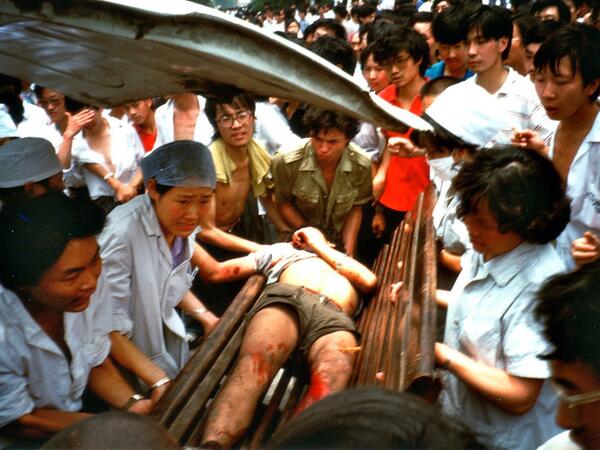
June 4, 1989, 10:15am – A man injured by police clutches his head as he waits for medical treatment in Chengdu.
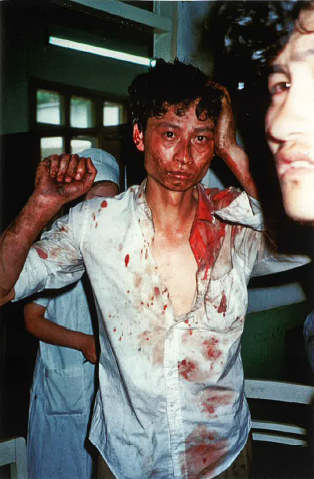
June 4, 1989, 10:30am – Angry protesters take to the streets again in Muxidi (western Beijing).
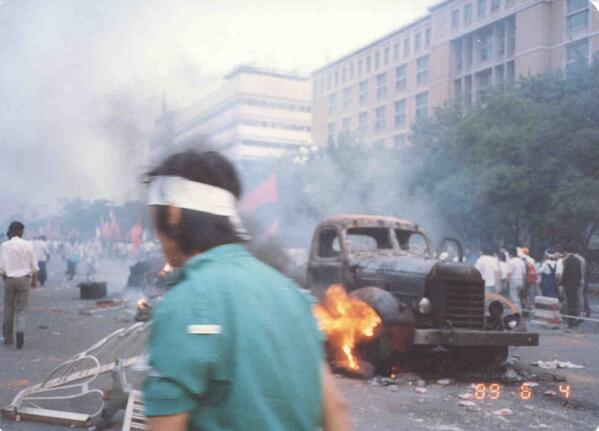
June 4, 1989, 10:30am – Enraged Beijing residents throw rocks at passing army vehicles.
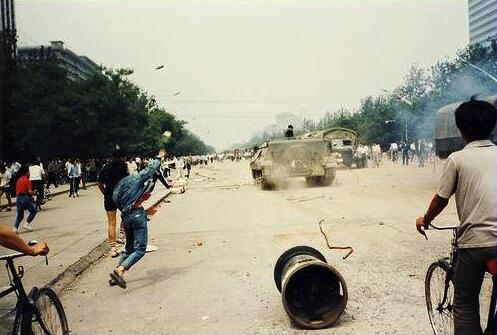
June 4, 1989, 10:30am – Enraged Beijing residents harass stalled army column of reinforcements at Muxidi.
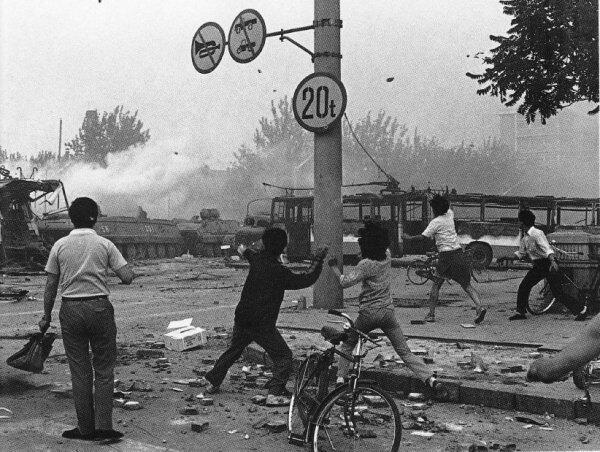
June 4, 1989, 10:45am – At Muxidi, protesters demand soldiers abandon stalled column of army vehicles.
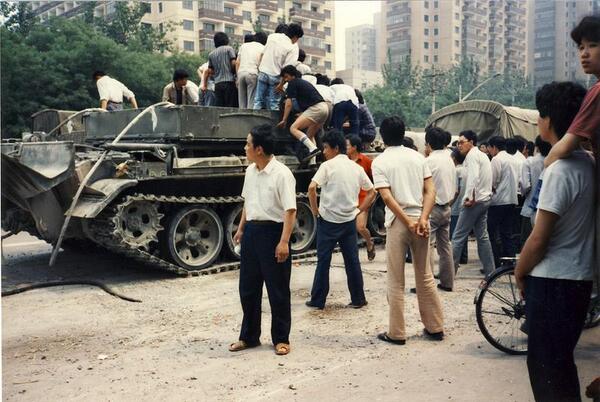
June 4, 1989, 10:45am – Soldiers in stalled column, many injured, abandon vehicles and seek refuge in Military Museum.
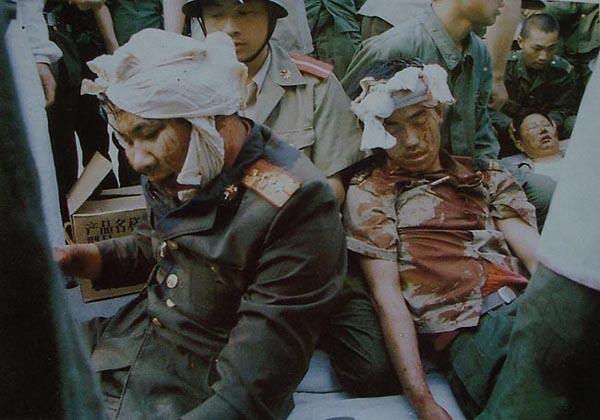
June 4, 1989, 10:45am – At Muxidi, angry residents set the now-abandoned column of army vehicles on fire.
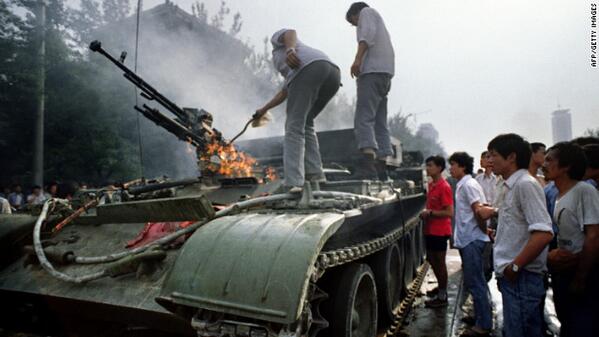
June 4, 1989, 10:45am – Residents at Muxidi (western Beijing) watch abandoned column of army vehicles burn.
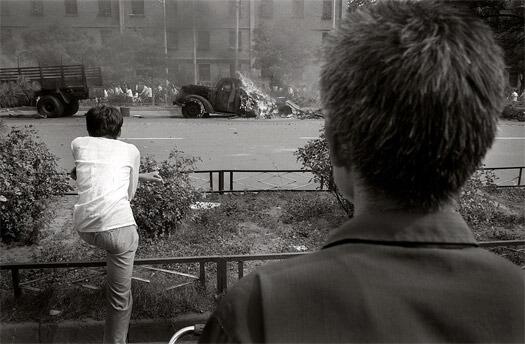
June 4, 1989, 10:45am – Man points to burning column of army vehicles in Muxidi.
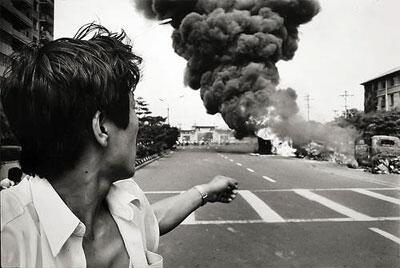
June 4, 1989, 10:45am – People on West Chang’an Ave watch smoke rise from entire column on army vehicles set ablaze.
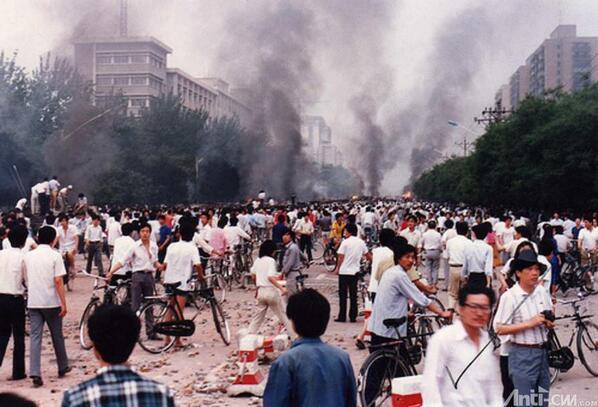
June 4, 1989, 11:00am – Column of abandoned APCs, set afire by angry Beijing residents, burns
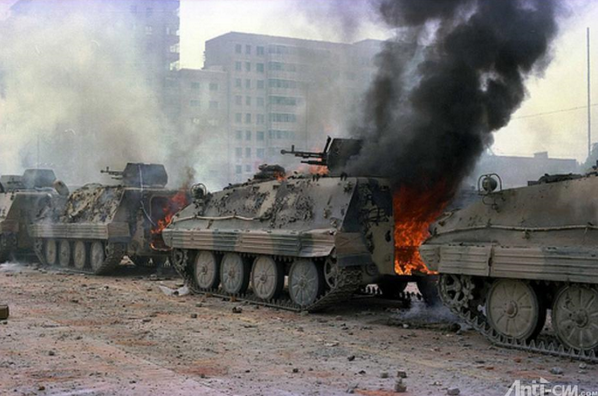
June 4, 1989, afternoon – Smoking ruins of entire army column torched by Beijing residents that morning at Muxidi.
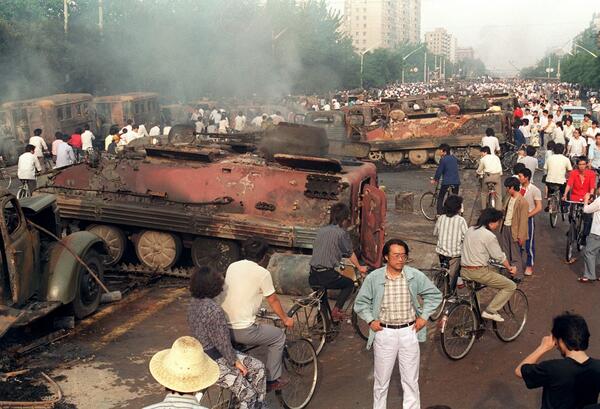
June 4, 1989 – New York Times: In Taiwan, sympathy and aloofness. “Tiananmen Square is very far away.”
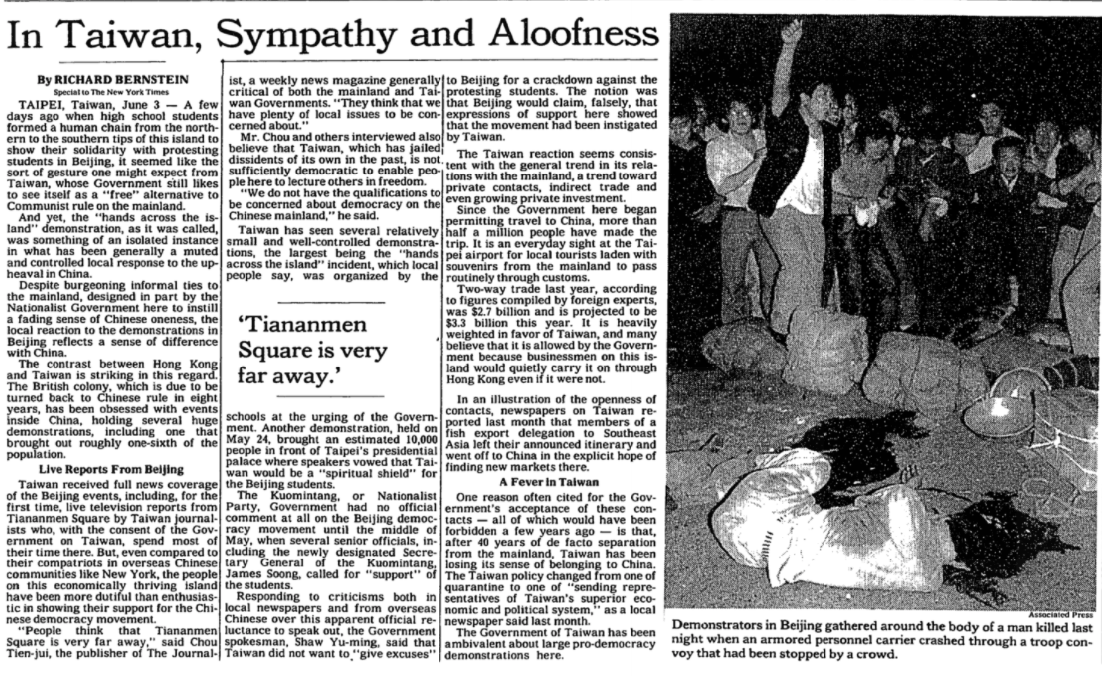
June 4, 1989, afternoon – Protesters in Chengdu throw rocks at police station, which they later set on fire.
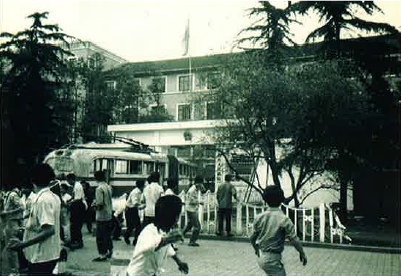
June 4, 1989, afternoon – Police truck burns in Chengdu following violent riots.
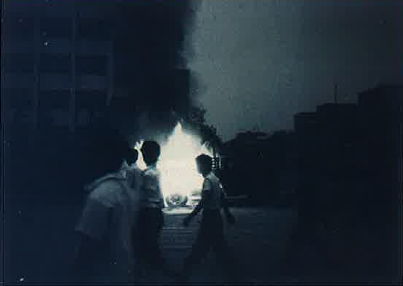
June 4, 1989, afternoon – Cyclists navigate around column of tanks advancing from Tiananmen east along Chang’an Ave.
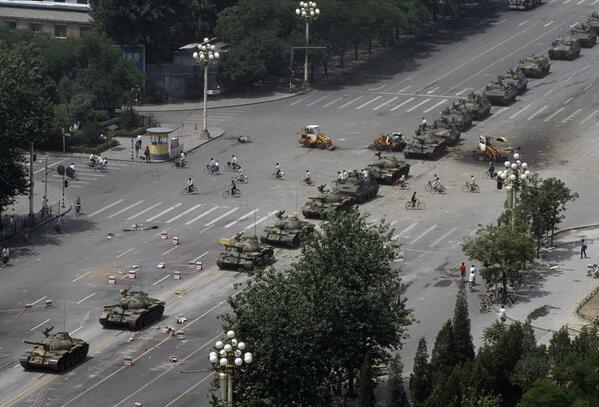
June 4, 1989, afternoon – Tanks drive past burned-out buses that served as barricades on Beijing’s Chang’an Ave.
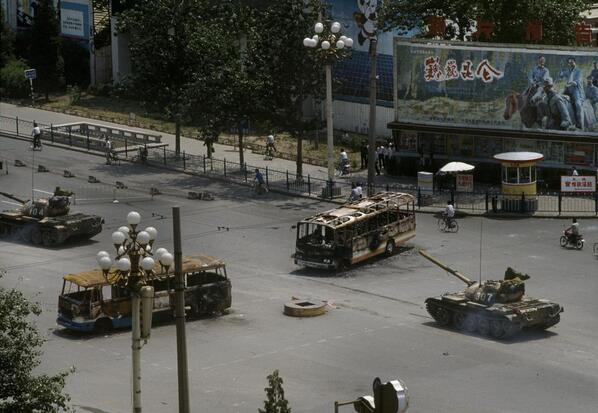
June 4, 1989 – New York Times: 300 irate protesters besiege China’s New York consulate.
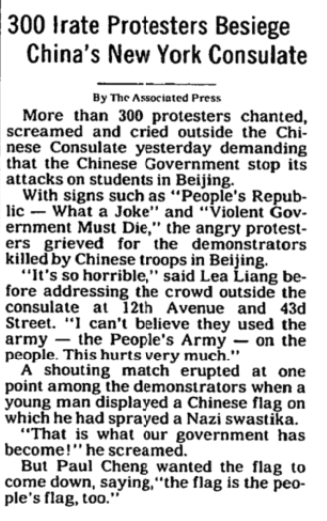
June 4, 1989, afternoon – After tanks pass, Beijing residents fill Chang’an Avenue in protest.
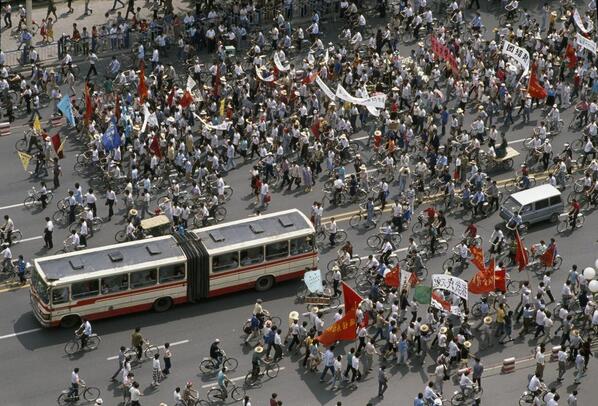
June 4, 1989, afternoon – Protesters fill Chang’an Ave in front of Beijing Hotel, just west of Tiananmen.
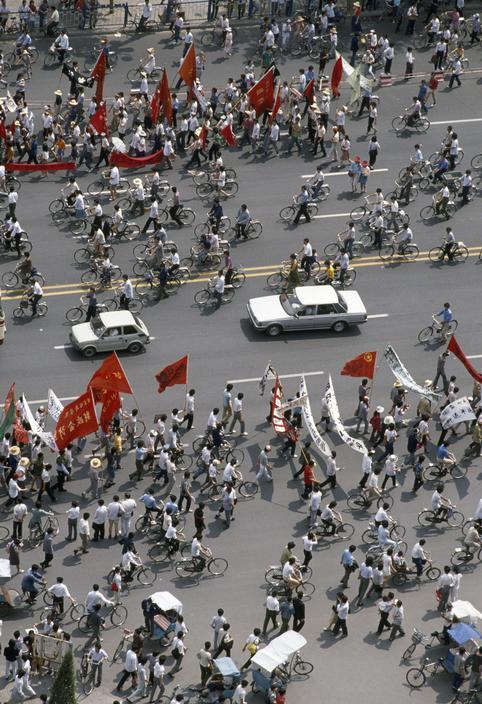
June 4, 1989, afternoon – Column of tanks advances along major street in Beijing.
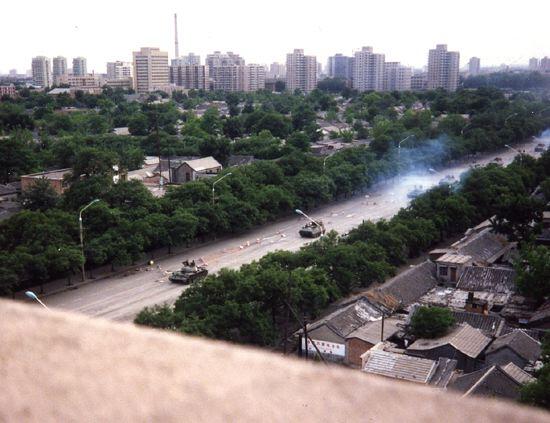
June 4, 1989, afternoon – Burning column of army vehicles in western Beijing.
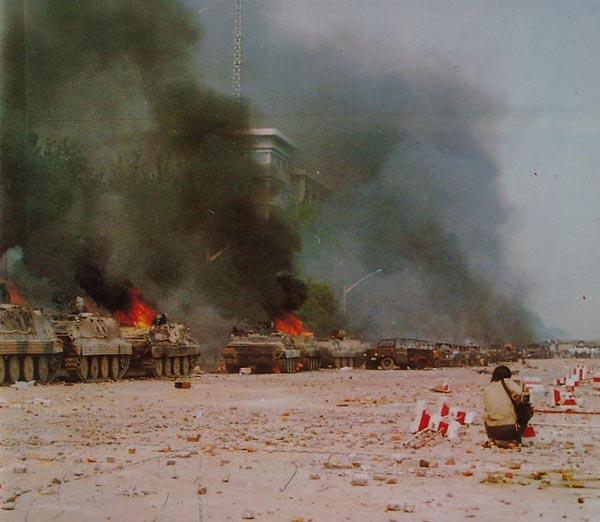
June 4, 1989, afternoon – Local residents examined burned-out column of army vehicles at Muxidi.
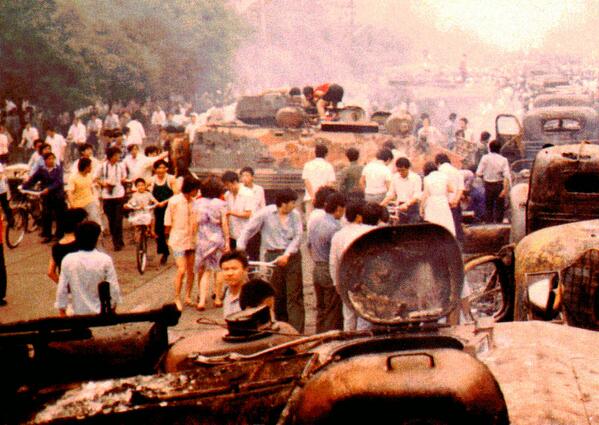
June 4, 1989, afternoon – Tanks secure overpass (at Chaoyang?) amid wreckage from previous night’s battle.
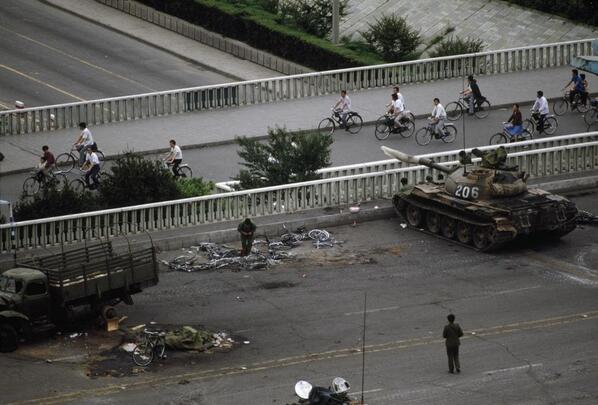
June 4, 1989, afternoon – Beijing residents make their way through shattered barricades just east of Tiananmen.
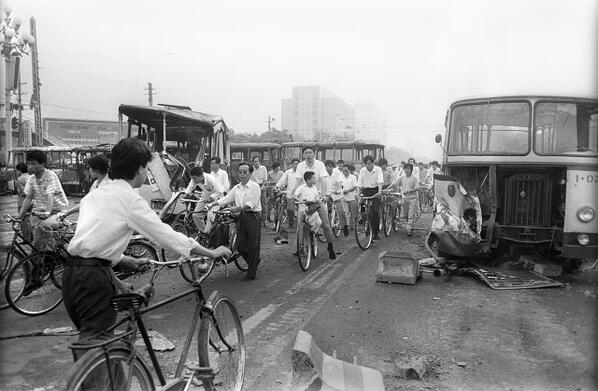
June 4, 1989, afternoon – A solitary figure stares across no-man’s land at firing line sealing off Tiananmen Square.
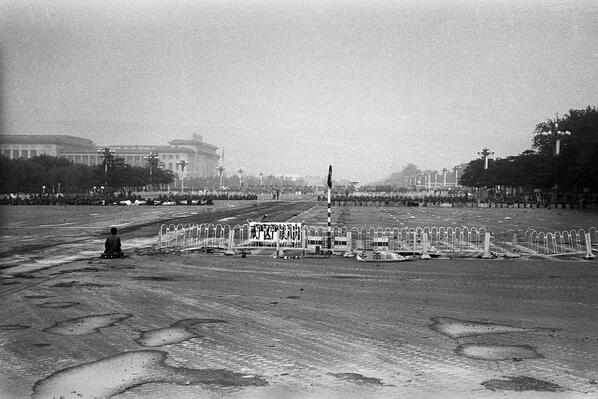
June 4, 1989, afternoon – Soldiers continue cleaning up traces of protest in Tiananmen Square.
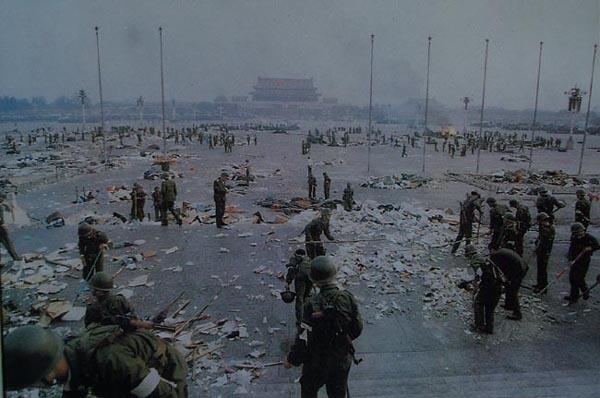
June 4, 1989, afternoon – Army helicopters land in Tiananmen Square to resupply troops.
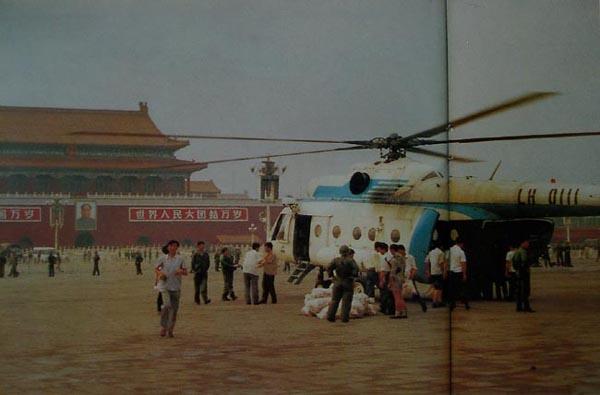
June 4, 1989, 7:00pm – Medical personnel count bodies in Beijing.
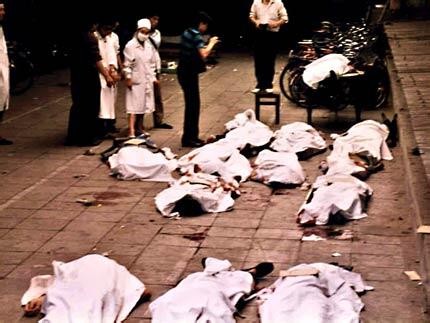
June 4, 1989, 7:00pm – Beijing residents search local morgues for missing family members.
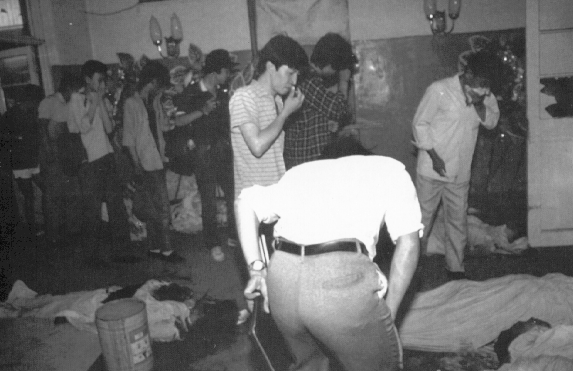
June 4, 1989, 7:00pm – Bodies stacked in a Beijing morgue.
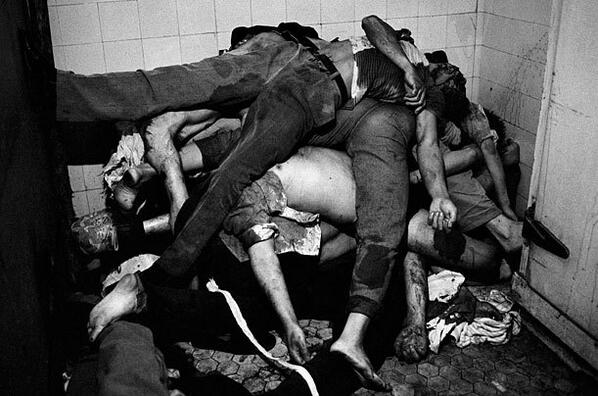
June 4, 1989 – On the very same day as bloody crackdown in China, Poland holds its first free elections since World War II.
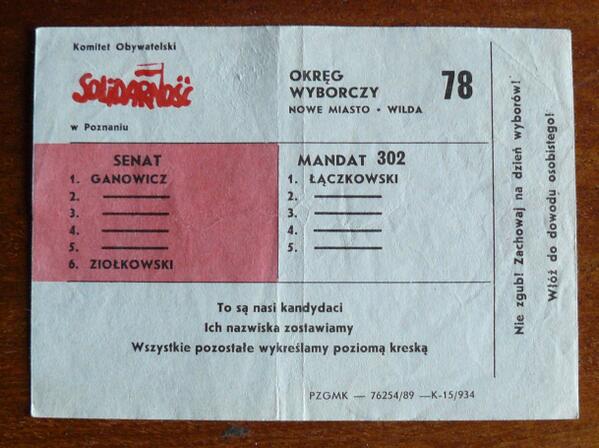
June 4, 1989 – In first free elections since World War II, Polish voters peacefully sweep Communist Party from power
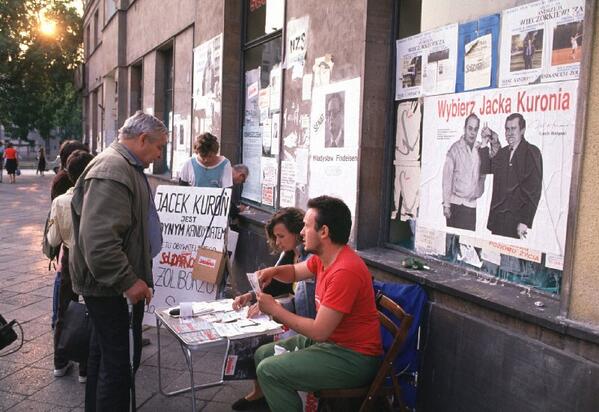
June 4, 1989, evening – Mother weeps upon finding her child’s body in a Beijing morgue.
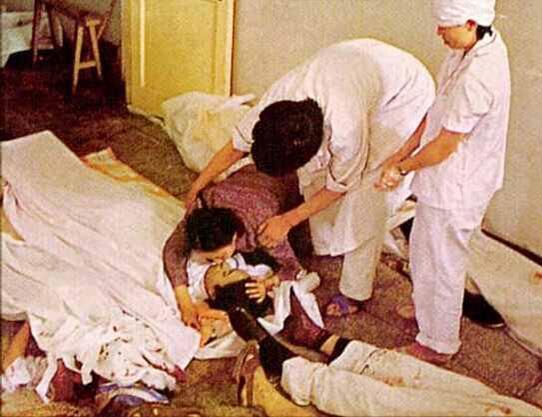
June 4, 1989 – Front page of South China Morning Post (Hong Kong). 57 killed?
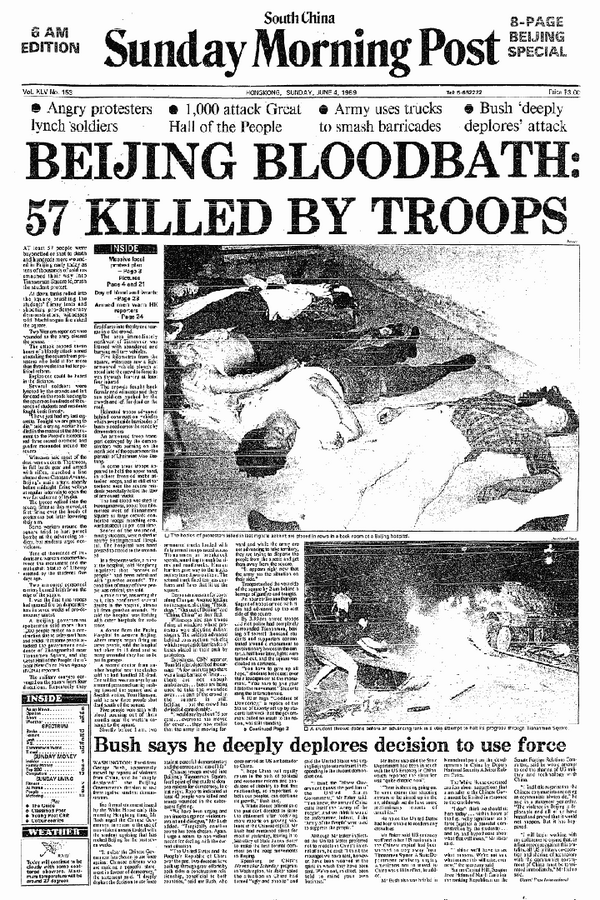
June 5, 1989 – Blood on Chang’an Avenue, central Beijing
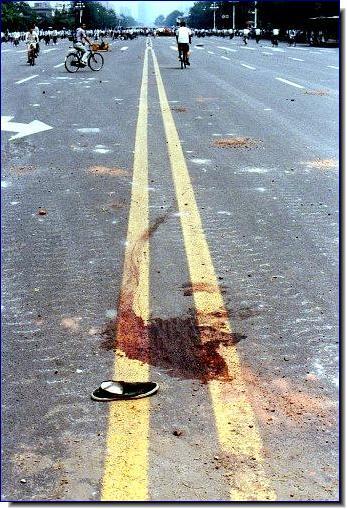
June 5, 1989 – New York Times: “troops…periodically responded with bursts of automatic-weapons fire whenever crowds drew close to the square.”
June 5, 1989 – Beijing residents pass wreckage of military vehicles destroyed the day before.
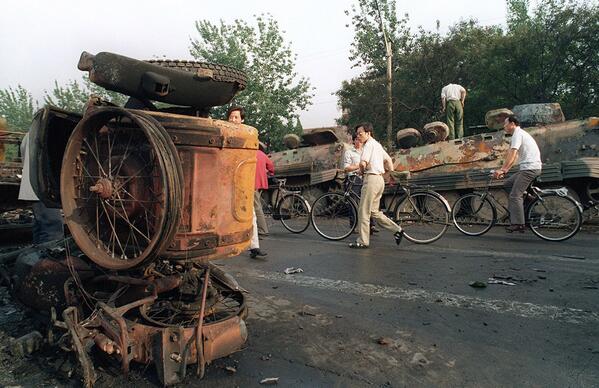
June 5, 1989 – New York Times: Beijing death toll at least 300.
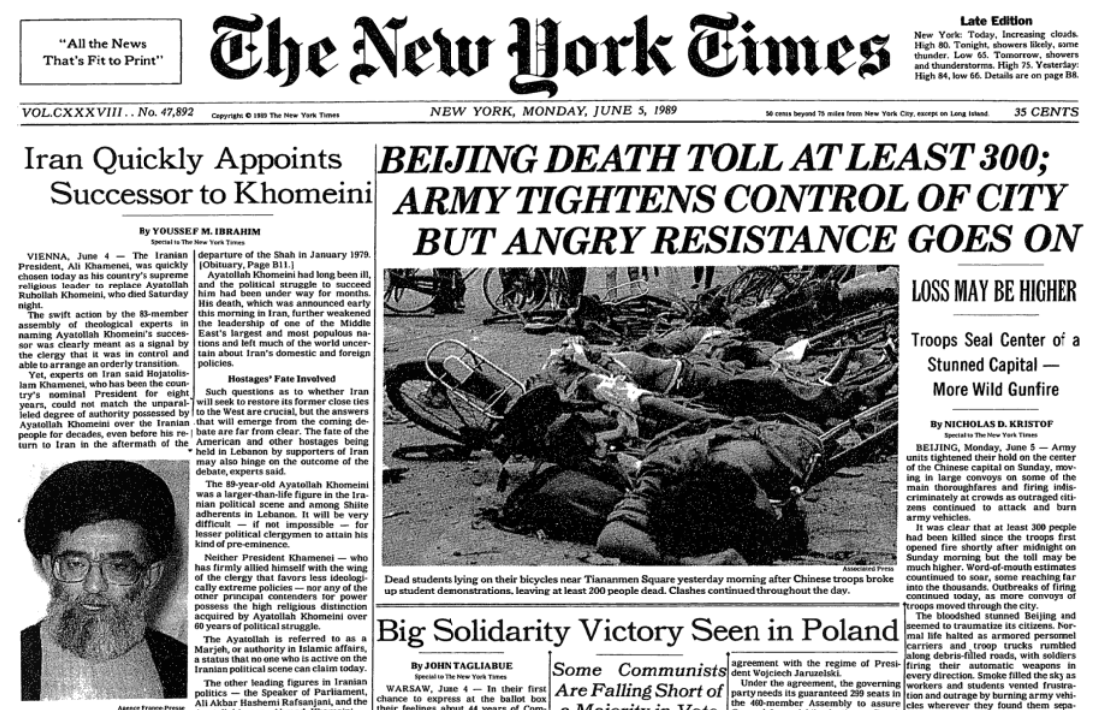
June 5, 1989 – Local Beijing residents show busload of tourists body lying in the street (Jianguomen bridge?)
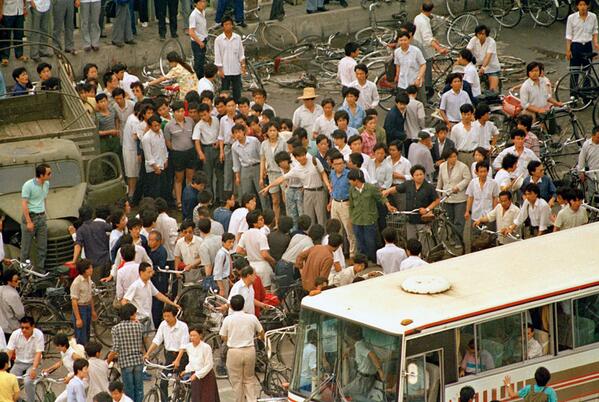
June 5, 1989 – Beijing residents beg foreign journalist to “tell the world” what happened the day before
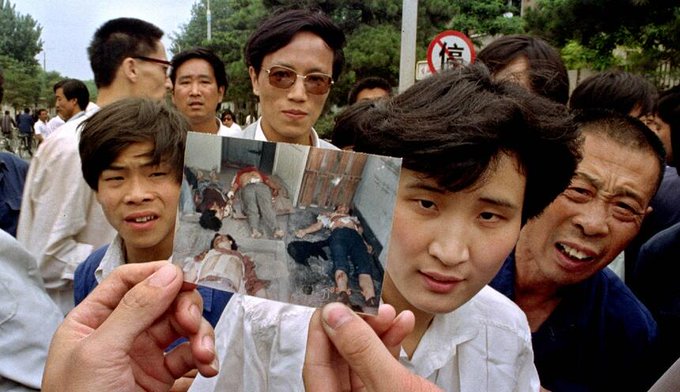
June 5, 1989 – Wife of wounded Party member tells New York Times: “He said such a party could never hurt the people. But he was wrong.”
June 5, 1989 – Students place white flower (to mourn the dead) over main gate to Peking University
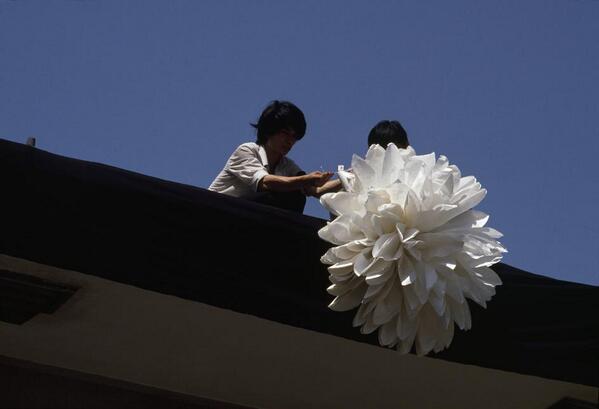
June 5, 1989 – Students hold funeral services on Beijing college campuses to mourn their fallen classmates.
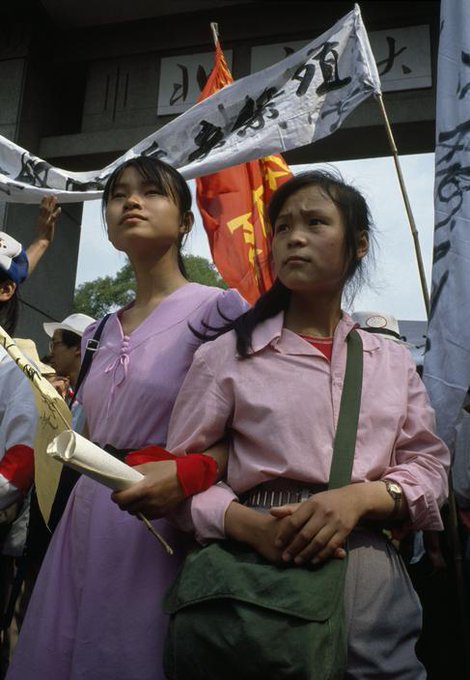
June 5, 1989 – Tanks parked on Tiananmen Square, seen from Beijing Hotel (a few blocks to the east)
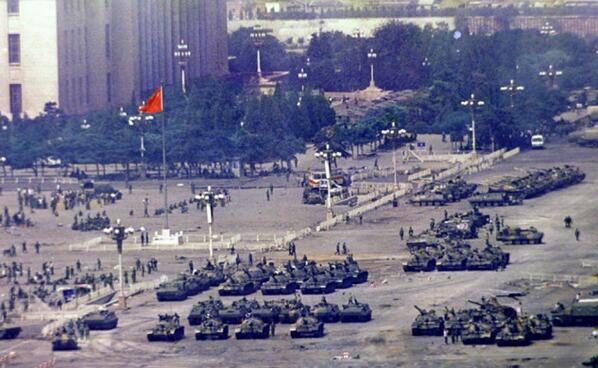
June 5, 1989 – New York Times: In Beijing, rage and despair over the soldiers’ brutality.
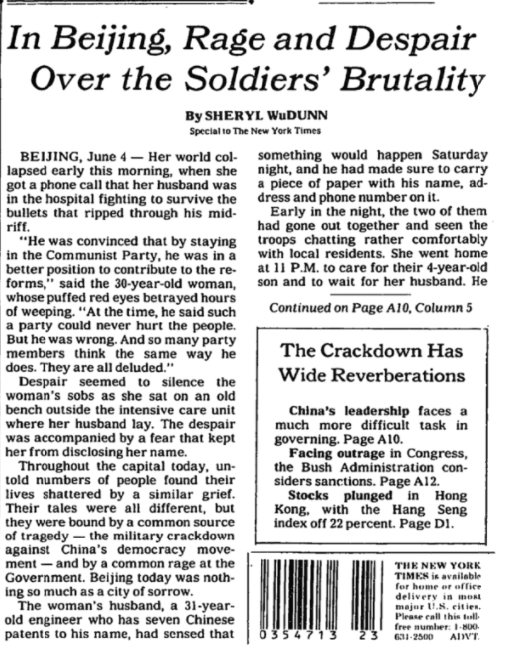
June 5, 1989 – New York Times reports shoppers on Wanfujing shot because they were in line of view when soldiers opened fire.

June 5, 1989 – Doctor at Beijing’s Union Medical College Hospital tells New York Times: ‘We have no more blood.”
June 5, 1989 – Doctor in Beijing: “We had to concentrate on those who were still living. We had to leave behind most of those who already were dead.”
June 5, 1989 – Shortly after noon, a column of tanks departs Tiananmen Square heading east on Chang’an Ave. Note man at lower left.
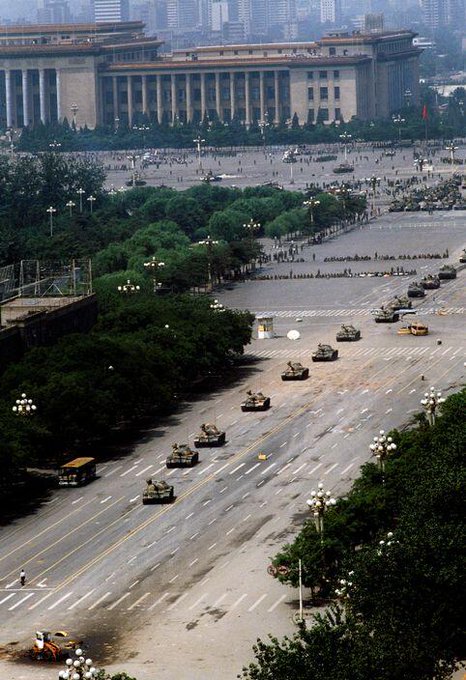
June 5, 1989 – People run from approaching tanks, just east of Tiananmen. Note man standing in street behind them.
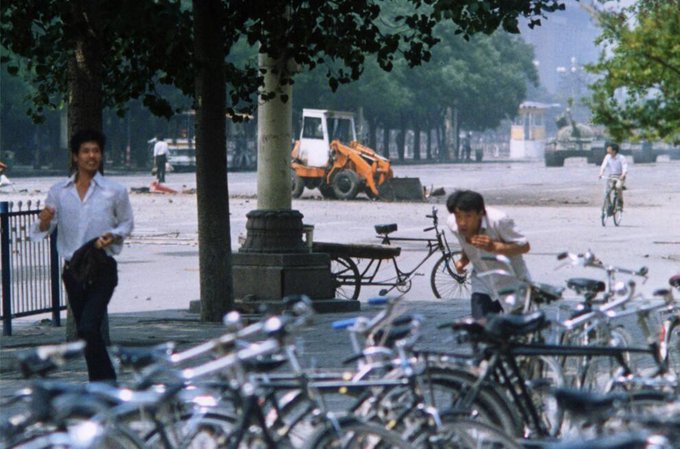
June 5, 1989 – Advancing column of tanks meets a lone man standing in the middle of the street
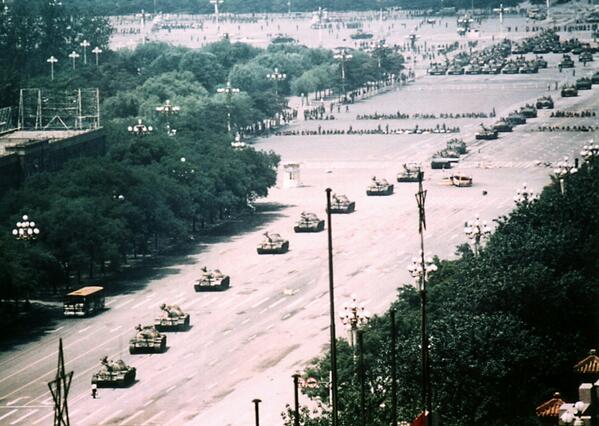
June 5, 1989 – Unknown man blocks column of tanks from advancing east on Chang’an Ave.
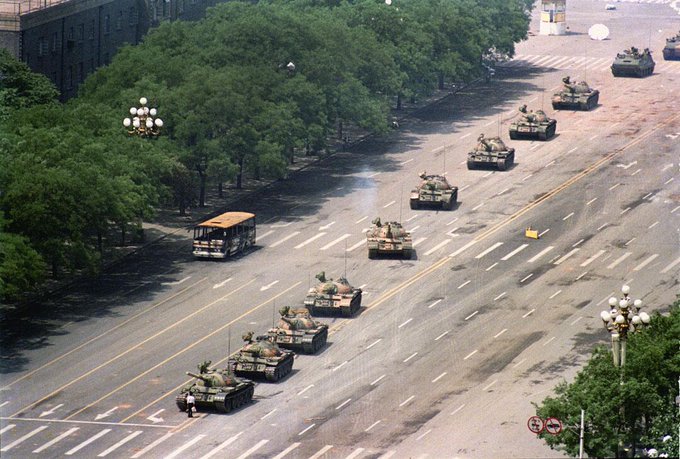
The exact same shot of Chang’an Avenue, just east of Tiananmen, in 2009
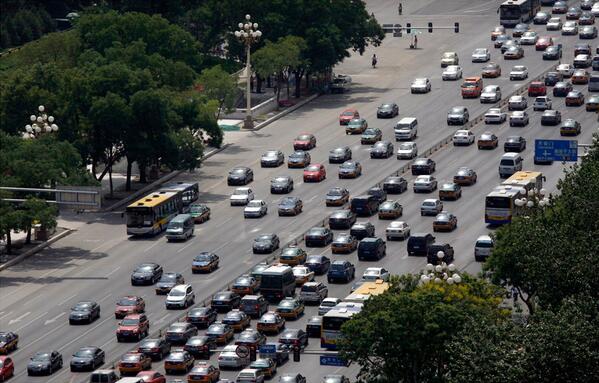
June 5, 1989 – The iconic photo of man vs. tank
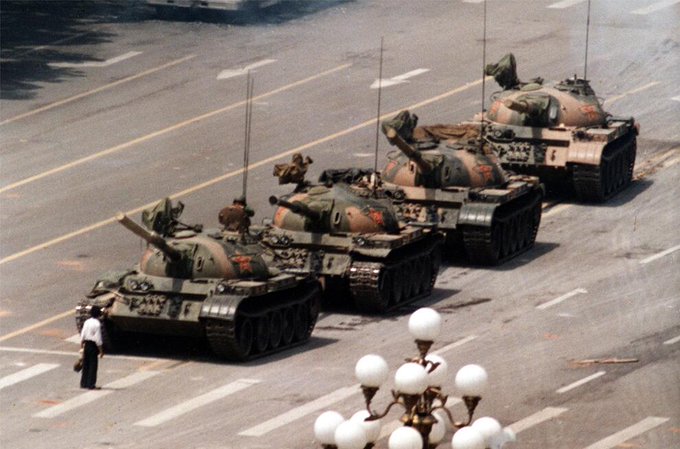
June 5, 1989 – The raw CNN video footage of one man facing down row of tanks in Beijing. Note sounds of gunfire.
June 5, 1989 – “Tank Man” finally being hustled away. By friends? Or plainclothes security forces? Nobody knows.
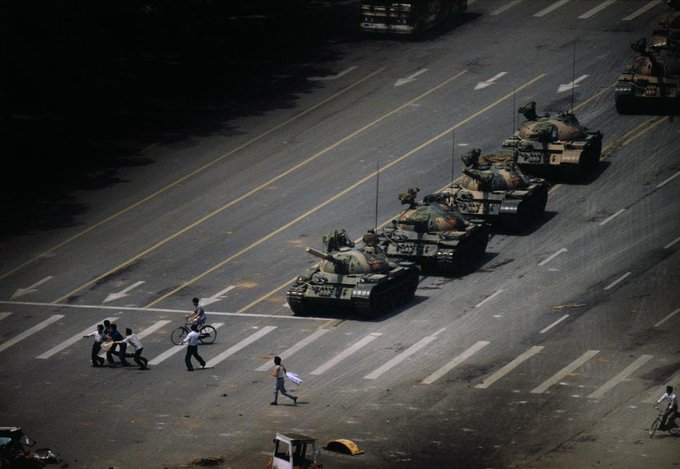
June 5, 1989 – 30,000 protesting students use buses as roadblocks, bring traffic to a standstill in downtown Shanghai.
June 5, 1989 – 7,000 protesting students bring traffic to standstill, block factory entrances in Xi’an.
June 5, 1989 – Truck filled with armed soldiers on Beijing street.
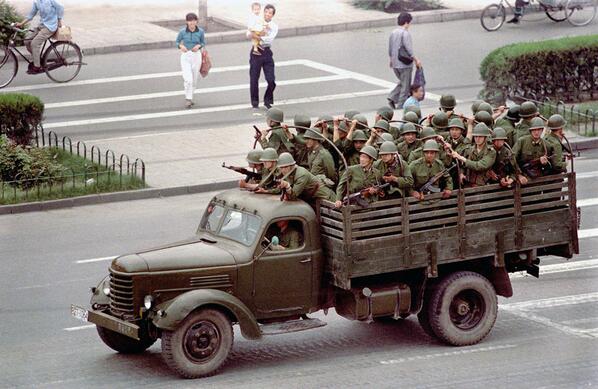
June 5, 1989 – Tanks deploy on Jianguomen bridge (East 2nd Ring Road). Ancient observatory is in background, to the southwest.
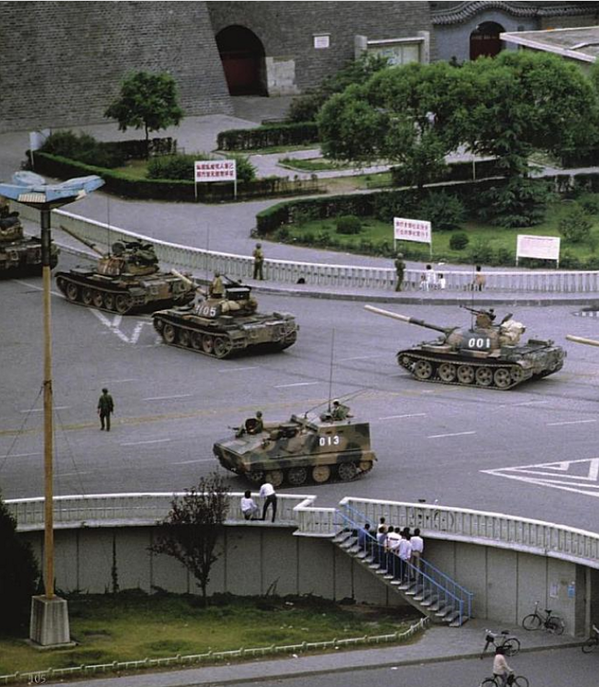
June 5, 1989 – Rioting protesters in Chengdu break into major hotels. Many are captured and beaten by police in Jinjiang hotel courtyard.
June 5, 1989 – Tanks on Jianguomen bridge. That’s my local subway station on northeast corner, I later lived in apt building behind it.
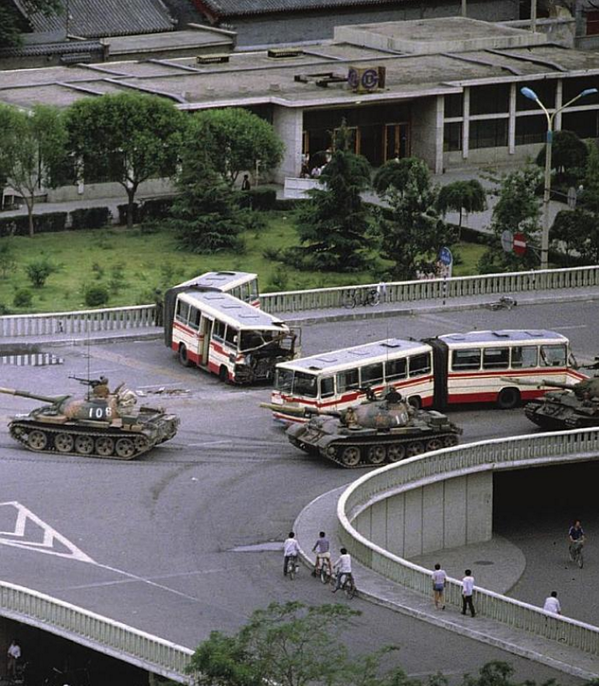
June 5, 1989 – Wuhan Steel reports “delivery of urgently needed materials has been blocked, and we will be forced to shut down.”
June 5, 1989 – New York Times: Hong Kong stock market plunges 22%. “There is no bottom.”
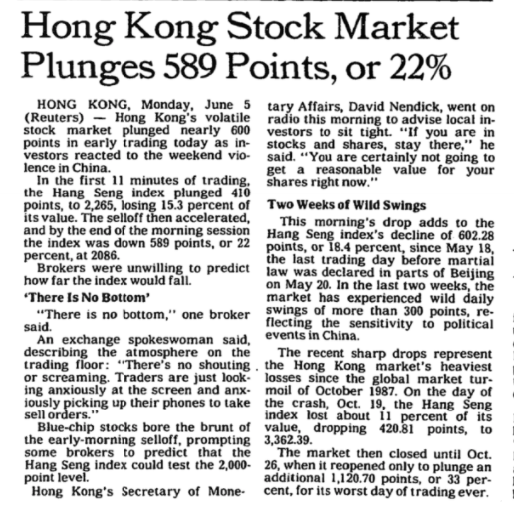
June 5, 1989 – Tanks deploy at Jianguomen, amid (inaccurate) rumors of potential civil war among rival army units.
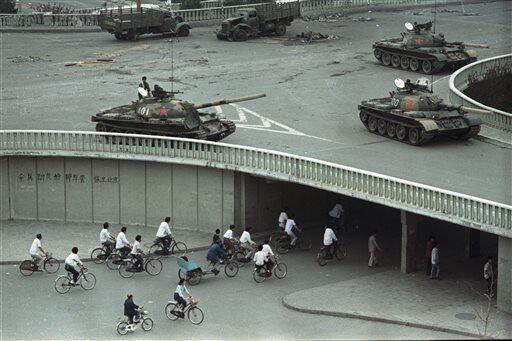
June 5, 1989 – Cyclists shelter while tanks deploy on Jianguomen bridge. Could be the view out my apartment window.
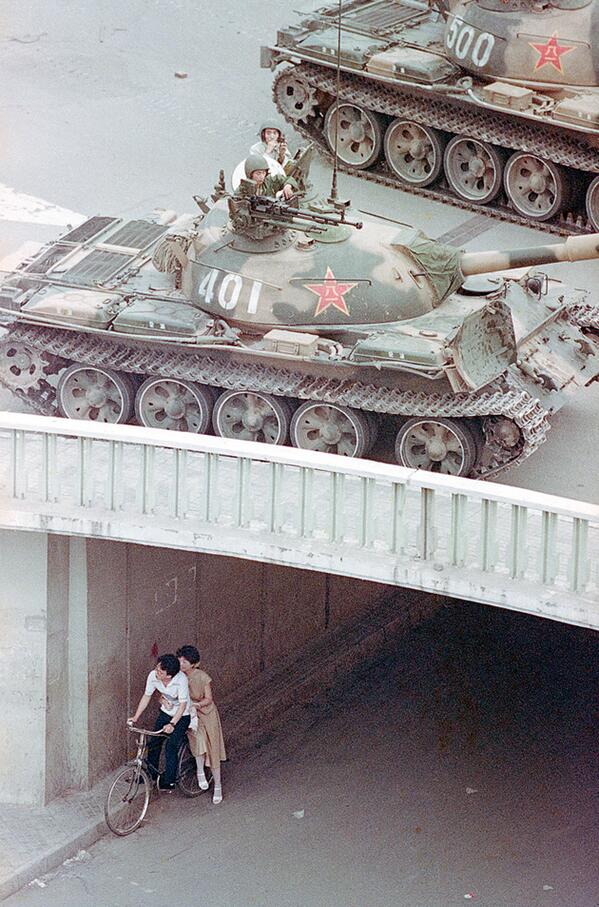
June 5, 1989 – New York Times: Violent crackdown may challenge Chinese rulers’ ability to govern.
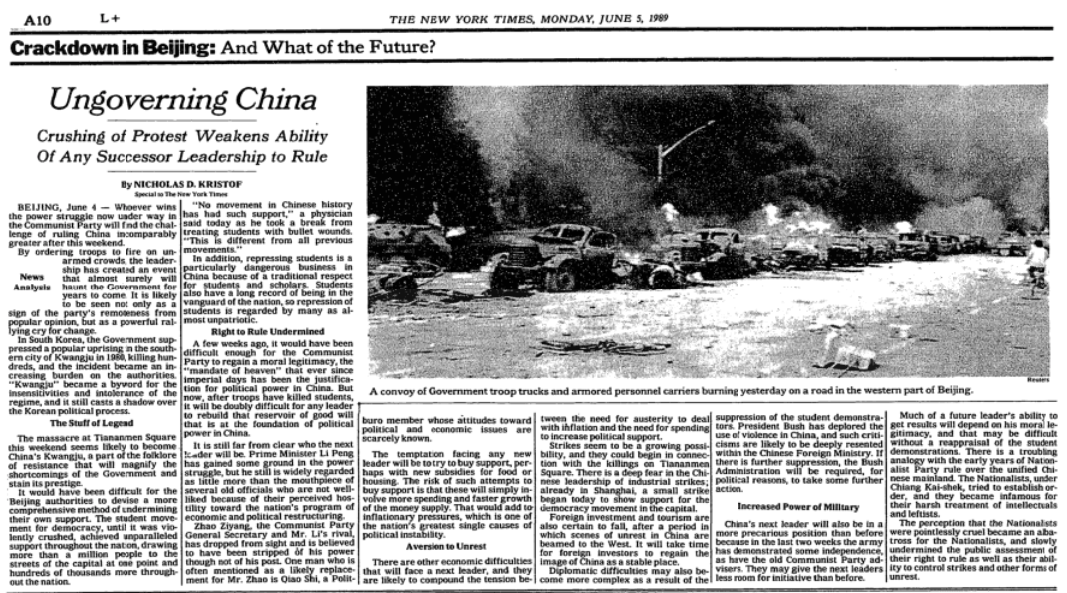
June 5, 1989 – Soldier waves pistol at onlookers approaching too close to tanks deployed on Jianguomen bridge.
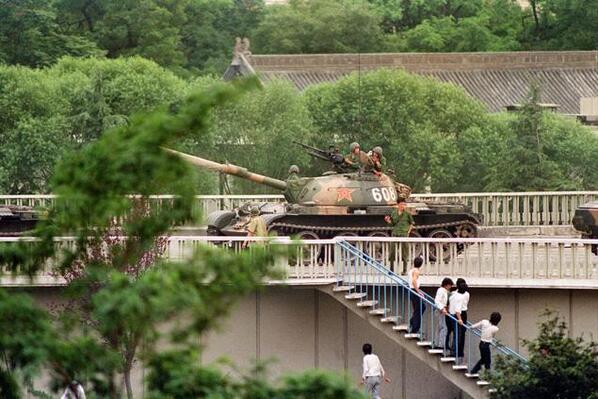
June 5, 1989 – 10,000 students erect roadblocks and block all traffic except for food supply trucks in Hangzhou.
June 5, 1989, 10:00pm – Groups of soldiers roam Beijing streets, shooting into air, amid rumors of tensions between units.
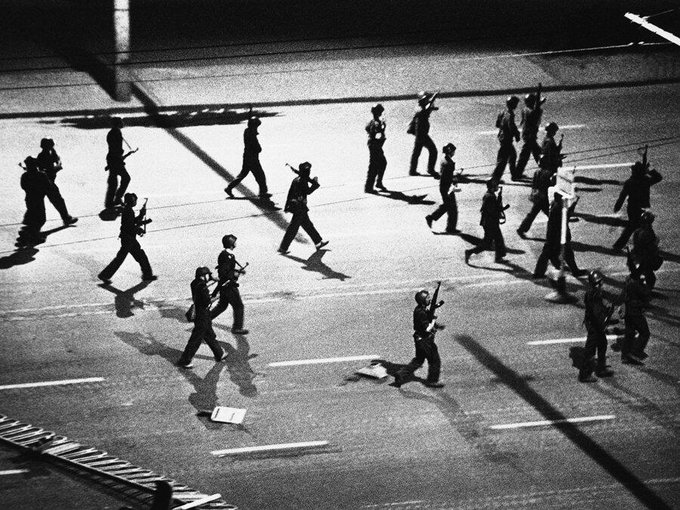
June 5, 1989, 11:00pm – Dissident Fang Lizhi is secretly picked up at Jianguo Hotel, brought to US embassy in Beijing.
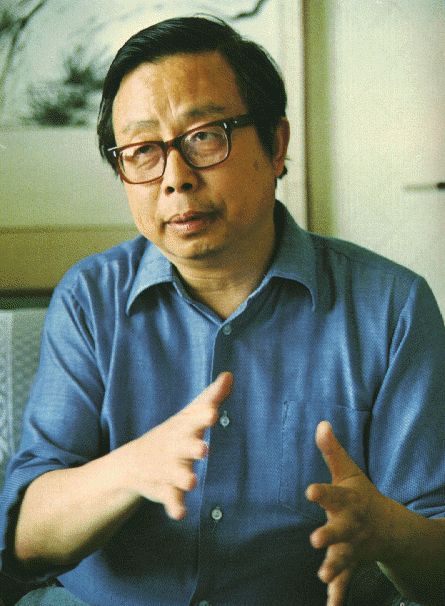
June 5, 1989 – US Ambassador Lilley with Fang Lizhi and his wife. They lived in US embassy until allowed to leave China a year later.
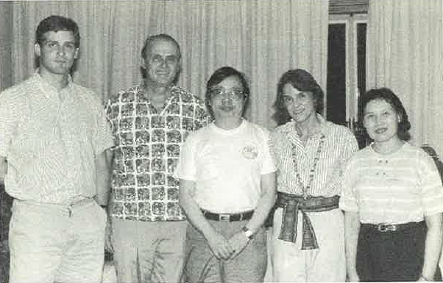
June 5, 1989 – New York Times: West considers how to respond to China’s crackdown.
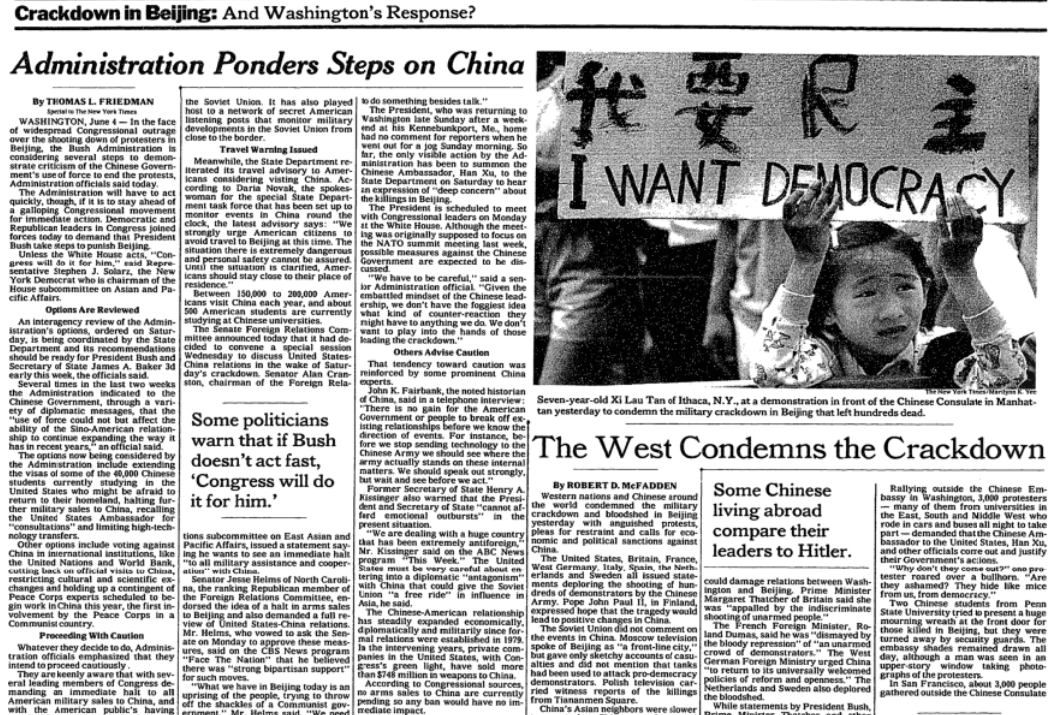
June 6, 1989 – Troops and tanks set up more established firing positions at northeast entrance to Tiananmen Square.
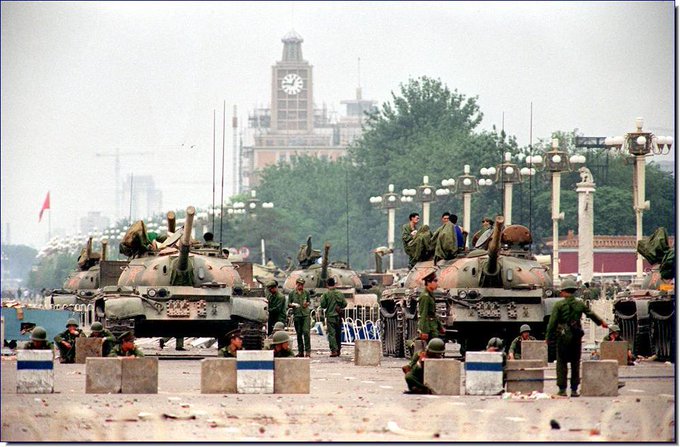
June 6, 1989 – Residents look on as troops maneuver through wreckage-strewn Chang’an Ave in central Beijing.
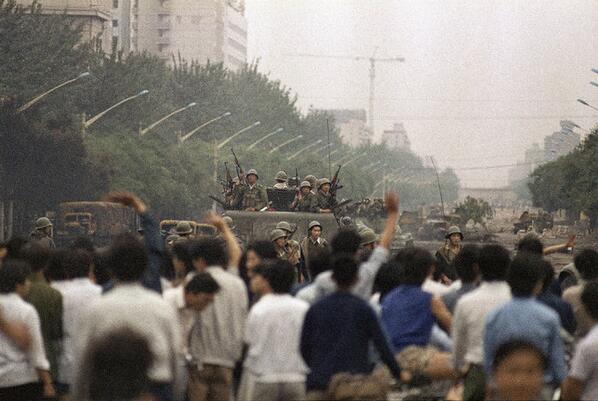
June 6, 1989 – Panicked residents in Guangzhou, in southern China, line up to stockpile rice, salt, sugar, eggs, and pork.
June 6, 1989 – New York Times: Army rift reported in Beijing, as shootings continue. Bush bars arms sales to China. In Poland, Communists concede defeat at ballot box.
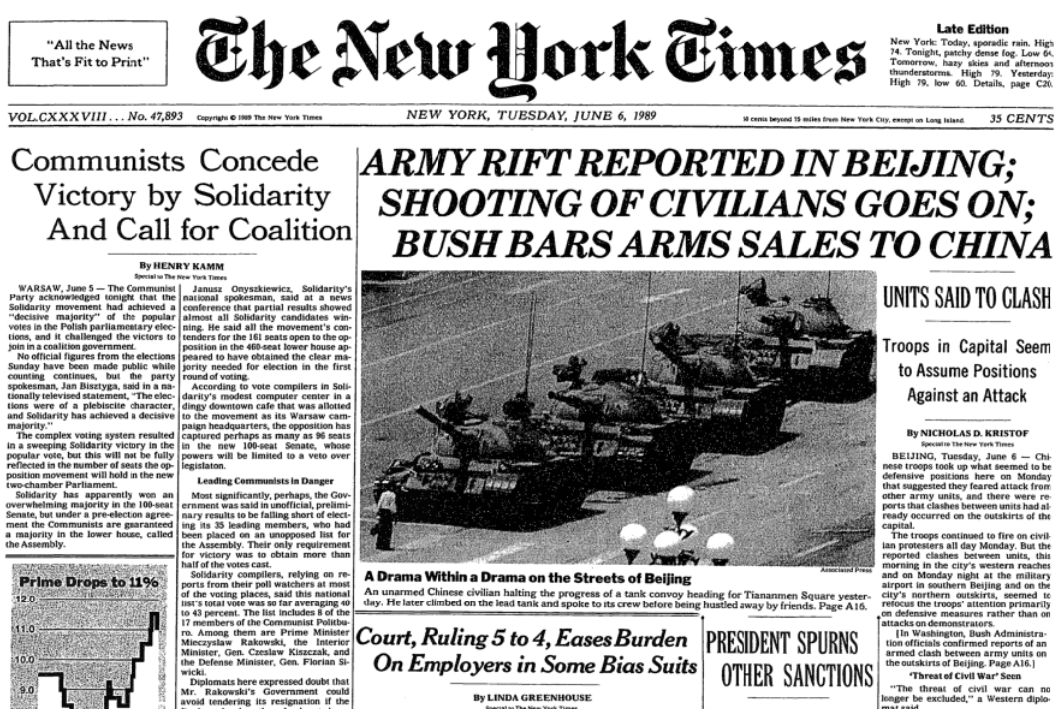
June 6, 1989 – 3,000 students and residents attack headquarters of 27th Army in Shijiazhuang, near Beijing, shouting “Butchers!”
June 6, 1989 – 100,000 protesters march in Changchun, in northeast China.
June 6, 1989 – 300 students interrupt traffic on major rail line by lying on tracks in Lanzhou, in northeast China.
June 6, 1989 – All day, police attempt to dismantle roadblocks put up by protesters occupying downtown Shanghai, to no avail.
June 6, 1989 – Shanghai: “Buses have stopped running. Barricades have been erected across main thoroughfares. Police are nowhere in sight.”
June 6, 1989 – In Chengdu, 2/3 of stores are closed. Rioters set fire to Sichan Exhibition Hall and loot jewelry store.
June 6, 1989 – Students in Wuhan, in central China, block downtown traffic as well as major North-South rail line, by lying on tracks.
June 6, 1989 – Posters saying “Hang Li Peng” and “Repay blood debts” are posted on nearly all buses in Guiyang, in southwest China.
June 6, 1989 – Soldiers taking a rest in army-controlled Tiananmen Square.
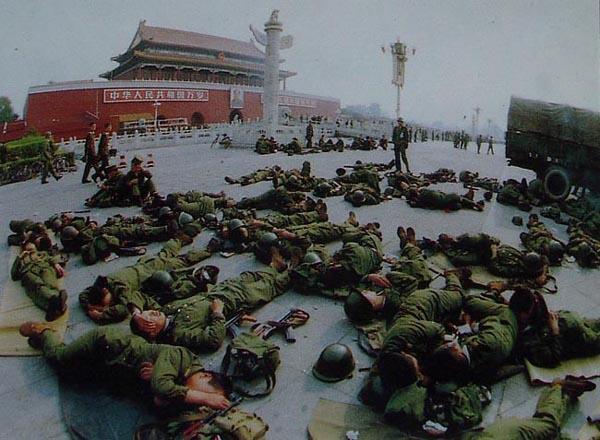
June 6, 1989 – Deng Xiaoping to Poiitburo Standing Committee: “If we hadn’t come down hard, who know what would have happened?”
June 6, 1989 – Deng Xiaoping: “We owe [the army] a lot, we really do…this was a very severe test and they passed.”
June 6, 1989 – Vice Premier Yao Yilin: “Our national economy’s been devastated since this turmoil began. Economic life is chaos.”
June 6, 1989 – Li Peng: “Facts…can show how despicable and crazy those Western reports of a Tiananmen bloodbath are.”
June 6, 1989 – Deng Xiaoping: “In the future…we will use severe measures to stamp out the first signs of turmoil as soon as they appear.”
June 6, 1989 – Deng Xiaoping: “We have to jump on anything that might bring instability…And we can’t care what foreigners say.”
June 6, 1989 – Deng: “This incident has been a wake-up call for all of us…All this boils down to one thing: China can’t take chaos.”
June 6, 1989 – Deng Xiaoping: “Of all China’s problems, the one that trumps everything is the need for stability.”
June 6, 1989 – Soldiers sharing a meal in Tiananmen Square. Food for the troops was in painfully short supply.
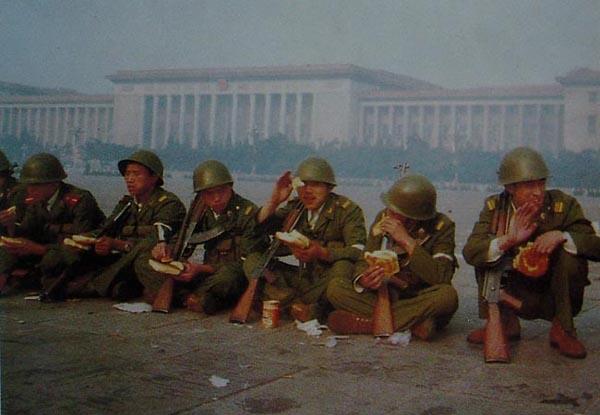
June 6, 1989, evening – US army attache in Beijing receives phone call warning to stay away from Jianguomen diplomatic residences the next day.
June 6, 1989, 8:45pm – No. 161 train from Beijing runs over 9 people blocking its path in Shanghai, 5 are killed.
June 6, 1989, 10:00pm – 30,000 gather at scene of fatal Shanghai train accident, riot and burn rail cars.
June 7, 1989 – New York Times: Broadcasts show widespread unrest across China, beyond Beijing.
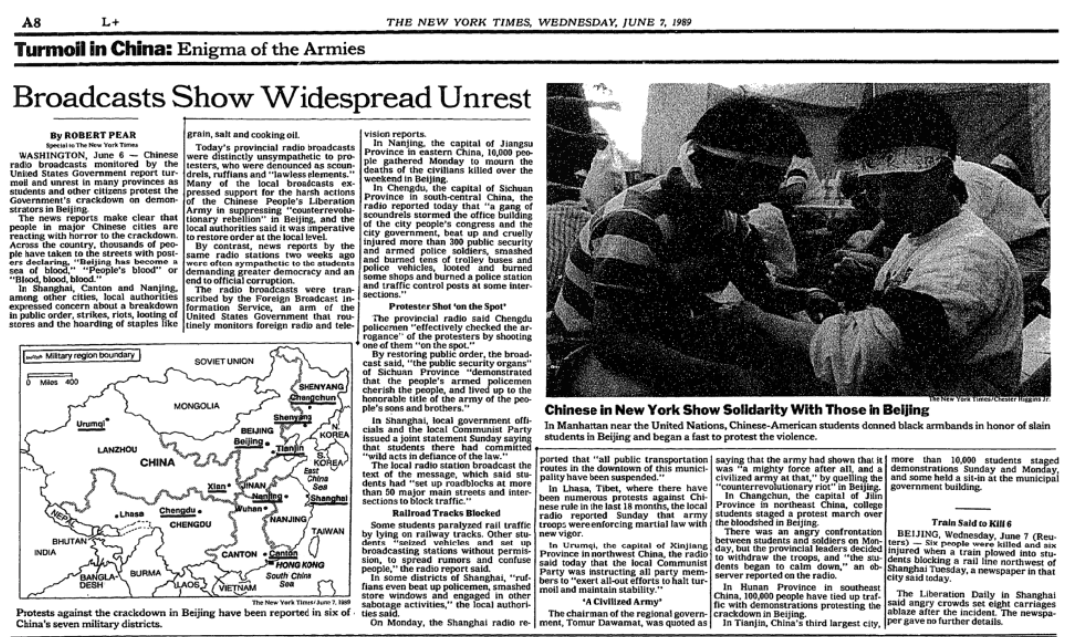
June 7, 1989 – Beijing residents gaze across army barricades blocking off northeast entrance to Tiananmen Square.
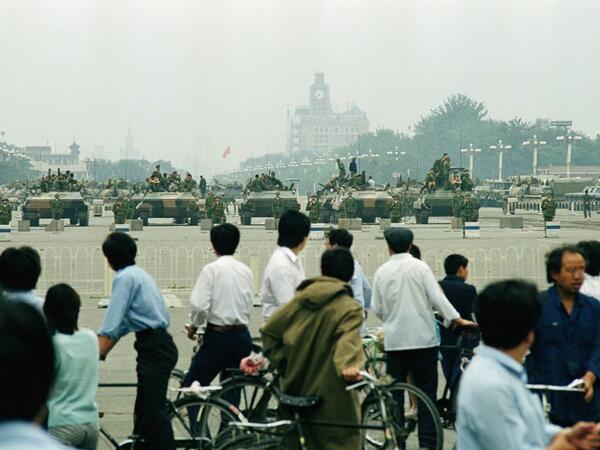
July 7, 1989 – New York Times: Map of latest reported developments around Beijing.
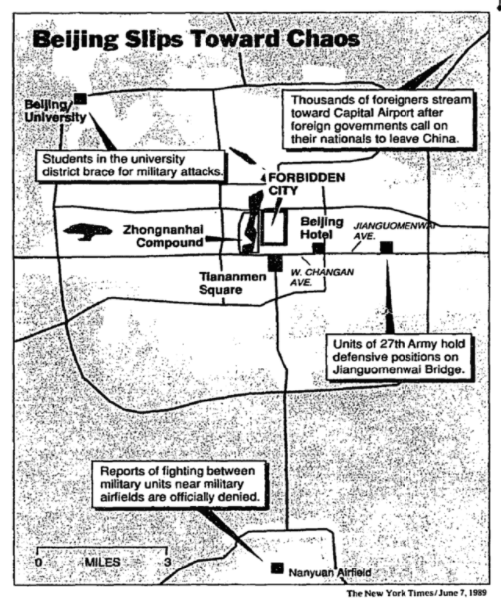
June 7, 1989 – Students lying on railroad tracks in Changsha, Nanjing, and Hangzhou block hundreds of trains along major routes.
June 7, 1989 – New York Times: Shanghai, at a standstill, waits apprehensively.
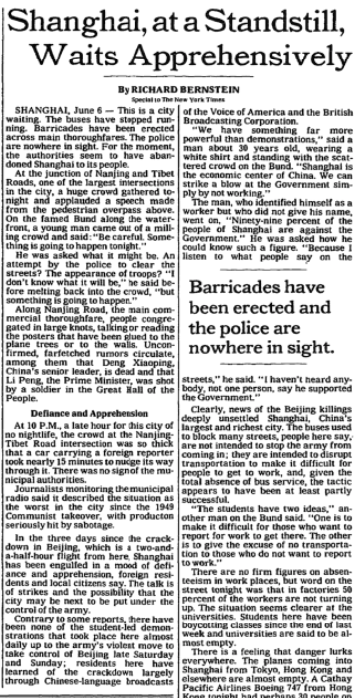
June 7, 1989 – New York Times: Japan reconsiders billions of dollars in aid to China.
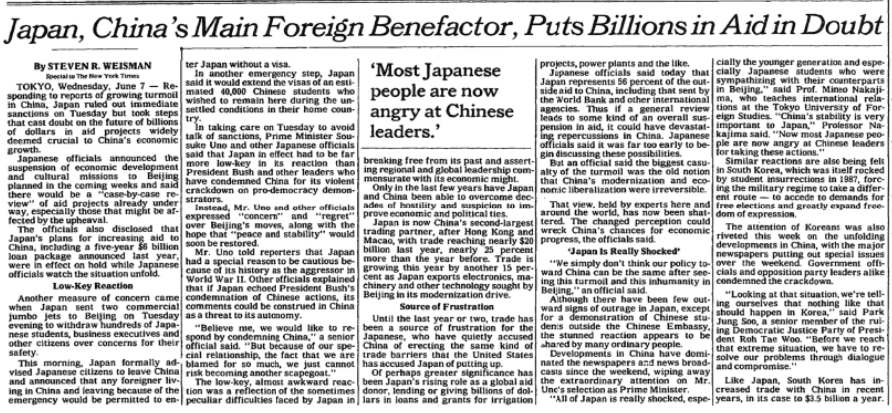
June 7, 1989 – Beijing residents take cover as truckload of armed soldiers passes by.
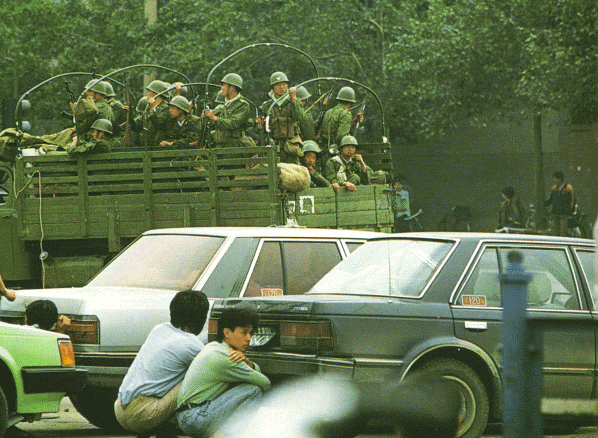
June 7, 1989 – New York Times: Thatcher stands by pledge to hand over Hong Kong to China.
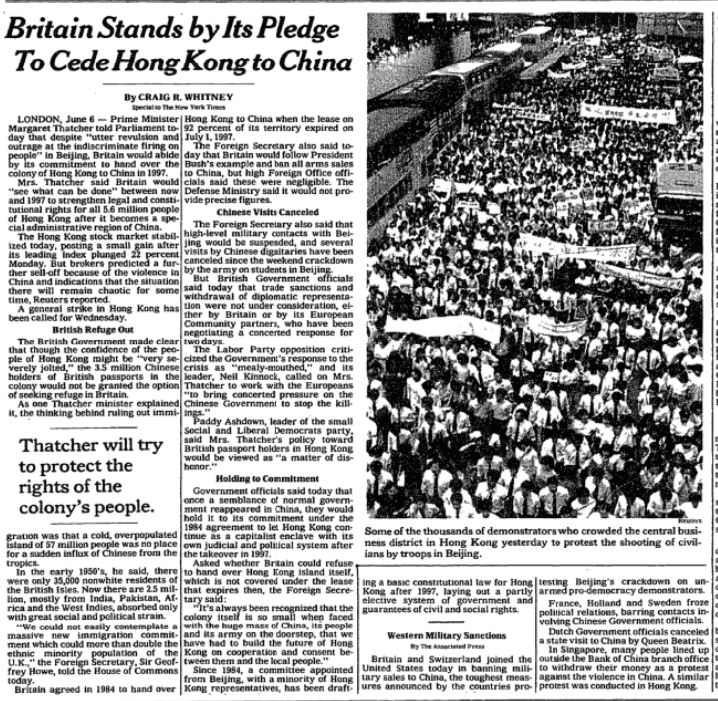
June 7, 1989 – Students in Wuhan block traffic and main bridge over Yangtze River; try to set fire to railroad cars but are stopped by police.
June 7, 1989 – Students in Taiyuan call on army units to fight their way to Beijing and hang Li Peng, Deng Xiaoping, Yang Shangkun.
June 7, 1989 – Truckload of armed soldiers patrols central Beijing, following crackdown.
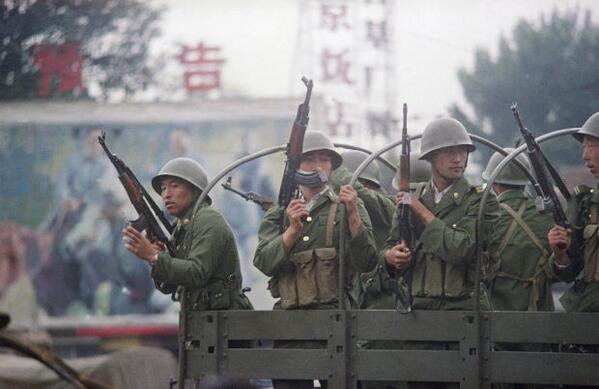
June 7, 1989, 10:00am – Chinese soliders open fire on upper floors of Jianguomen Diplomatic Residential Compound in Beijing. Due to phoned warning to US military attache the night before, only a few people were in Jianguomen DRC and they luckily escaped injury.
June 7, 1989 – Based Nick Kristof’s report, it appears soldiers fired on Qijiayuan DRC, not nearby Jianguomenwai DRC.
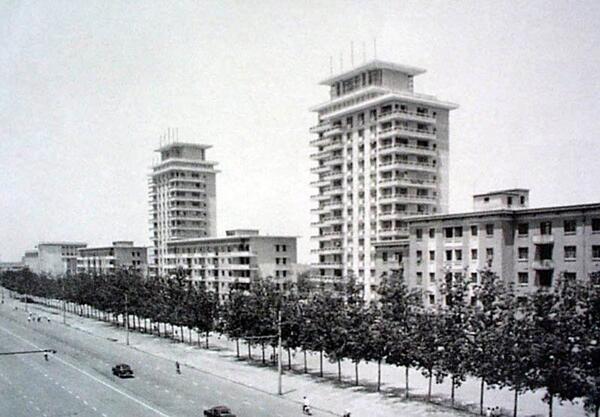
June 7, 1989, 12:00pm (noon, US time) – Secretary of State James Baker orders evacuation of all non-essential US citizens from China.
July 7, 1989 – New York Times: US makes plans to airlift Americans out of China.
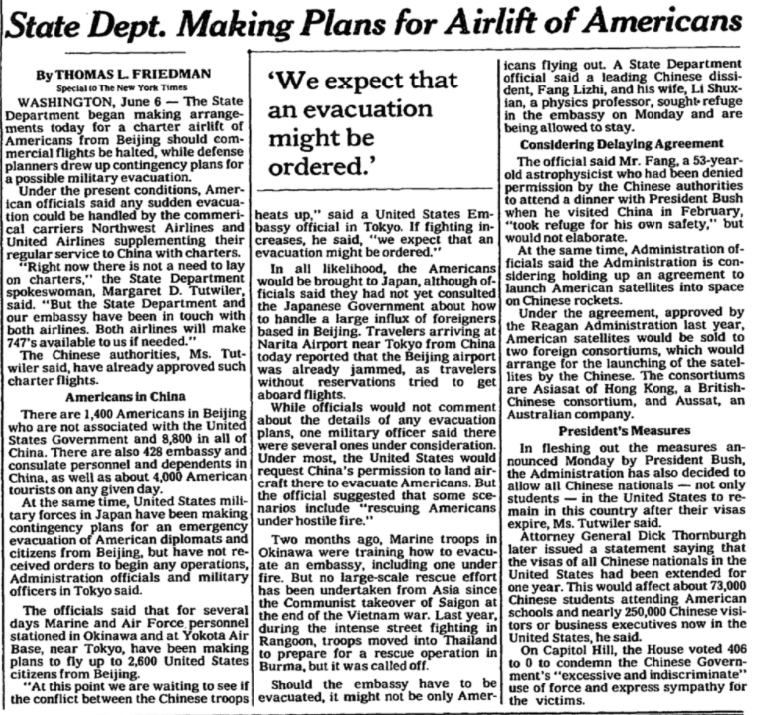
June 7, 1989 – Swastika drawn on destroyed APC, covered with tangled bicycles, in central Beijing.
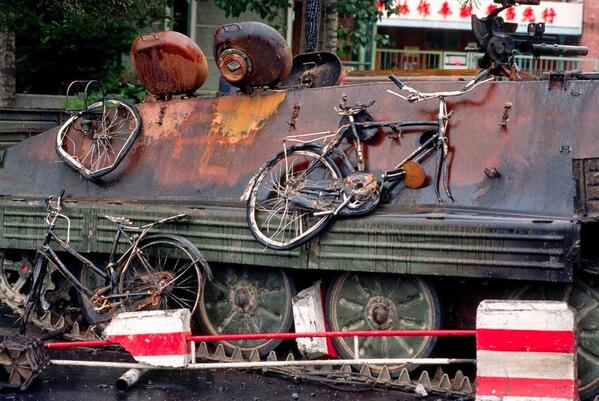
June 7, 1989 – In Shijiazhuang, residents and students stage sit-in at headquarters of 27th Army, blamed for the worst violence in Beijing.
June 7, 1989 – 300 Chinese employees of the United Nations hold emotional memorial service.
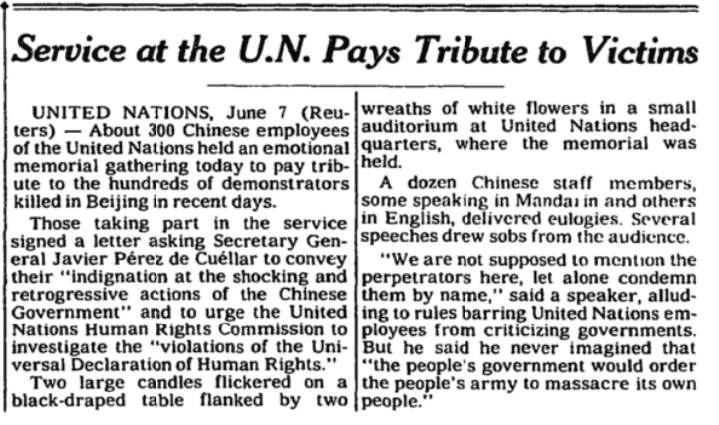
June 7, 1989 – Beijing residents gather around street poster denouncing the violent army crackdown.
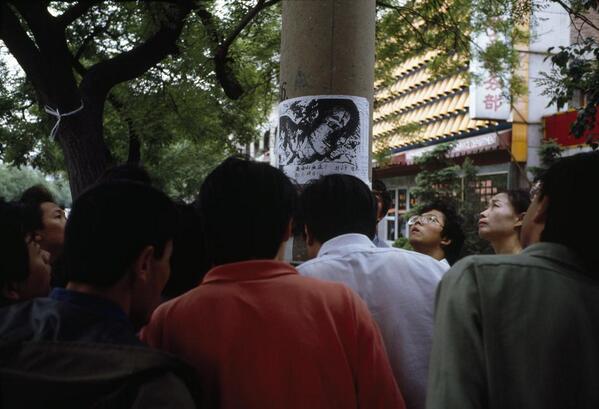
June 7, 1989 – New York Times: Soviets criticize foreign pressure on China following crackdown.
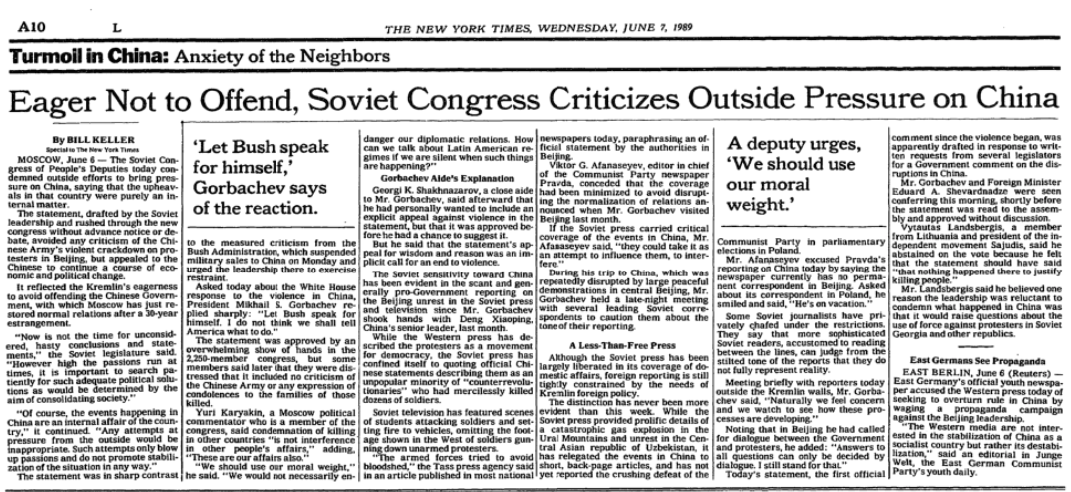
June 7, 1989 – Students storm auditoriums and classrooms at Shanghai college campuses to erect biers to honor dead in Beijing.
June 7, 1989 – Roadblocks manned by students continue to block virtually all traffic in Shanghai, amid rumors martial law may be declared.
June 7, 1989 – New York Times: Foreigners scramble to leave Beijing.
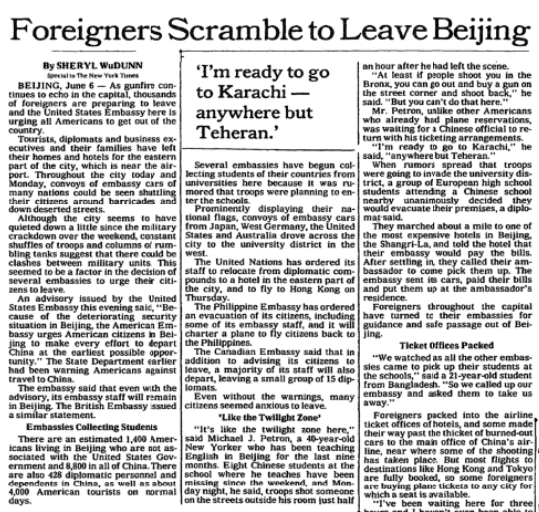
June 8, 1989 – Beijing residents injured in altercation with martial law troops.
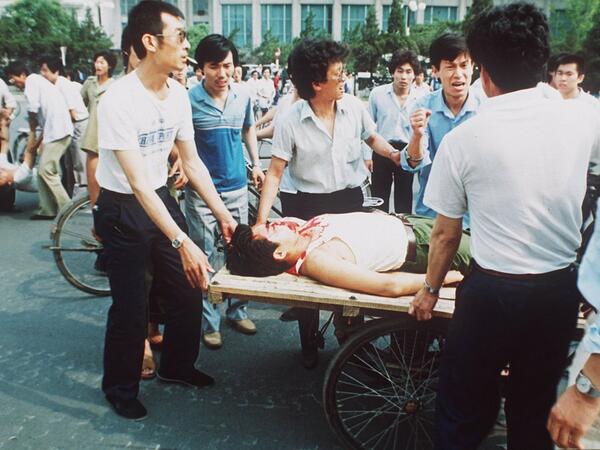
June 8, 1989 – With most markets closed, Beijing residents line up for food.
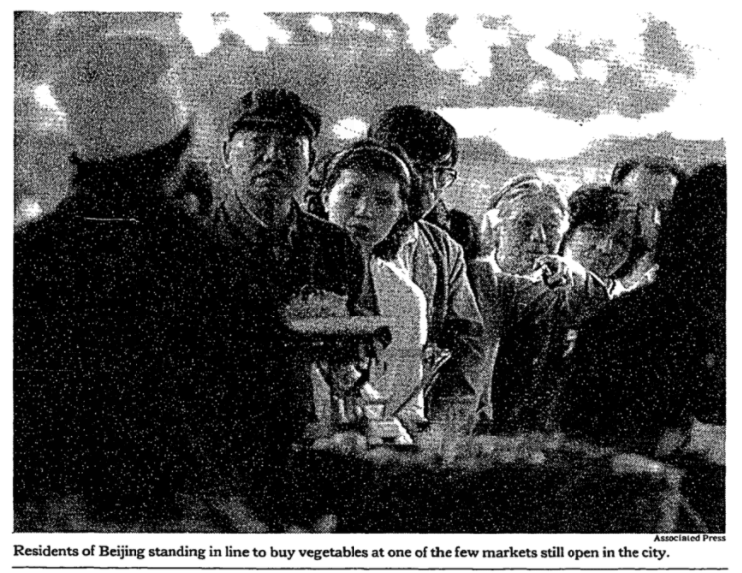
June 8, 1989 – New York Times: Foreigners tell of fear and chaos in Beijing.
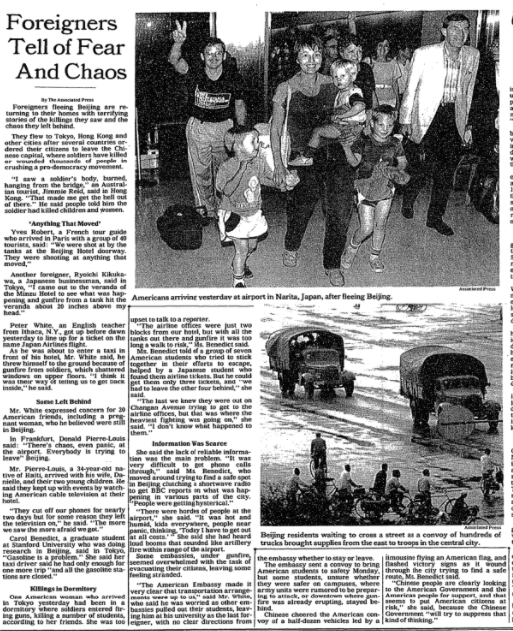
June 8, 1989 – One third of Shanghai factory workers don’t show up to work, many factories halt or slash production, electricity usage plummets.
June 8, 1989 – Mayor Zhu Rongji gives TV speech, says “Shanghai cannot afford any turmoil”, but pledges not to call in the army.
June 8, 1989 – Travelers sleep in Shanghai train station after trains have been stopped by unrest.
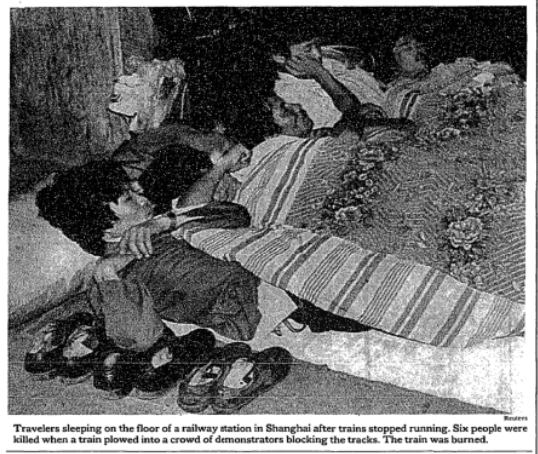
June 8, 1989 – New York Times: After decades of restrain, Japan criticizes China.
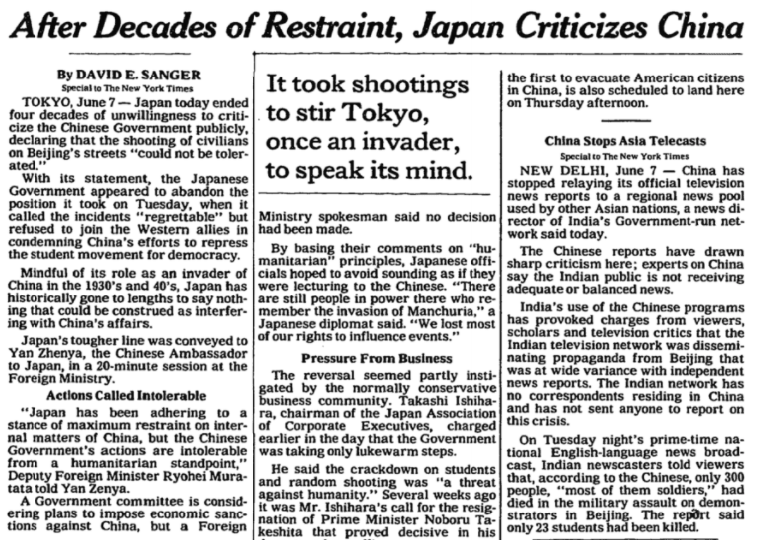
June 8, 1989 – Martial law soldiers guard intersection in central Beijing.
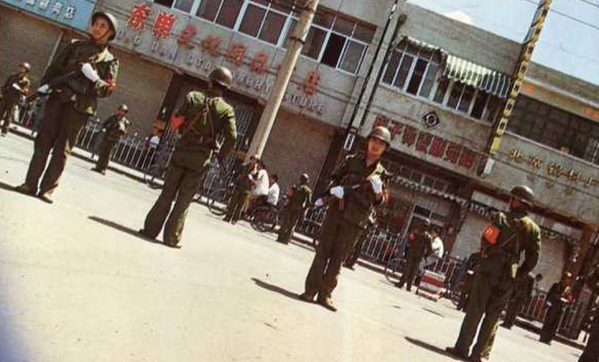
June 8, 1989 – Thousands of soldiers march down Beijing’s East Chang’an Ave shouting “Down with chaos! Fight the counterrevolutionaries!”
June 8, 1989 – New York Times: “One American diplomat found 50 bullet holes in his apartment.”
June 8, 1989 – British diplomats and their families evacuate Beijing.
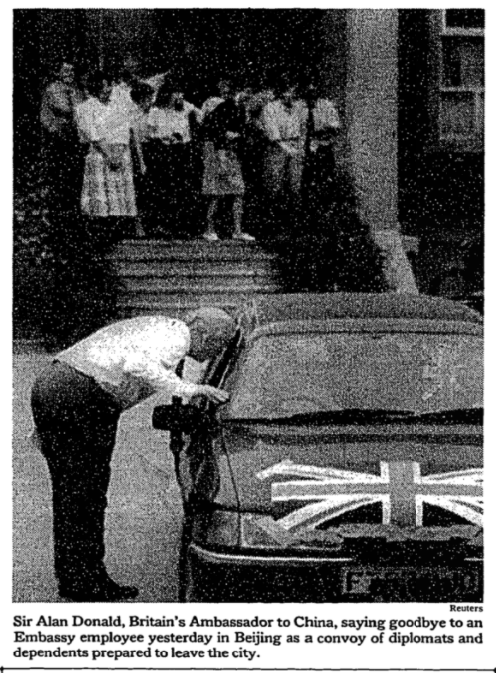
June 8, 1989 – New York Times: Foreboding grips Beijing.
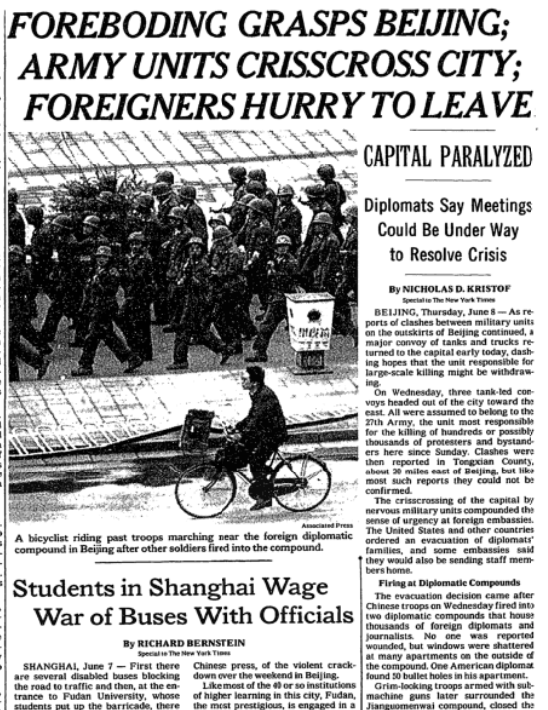
July 8, 1989 – New York Times: US says 200,000 troops near China’s capital, has no idea who is running the country.
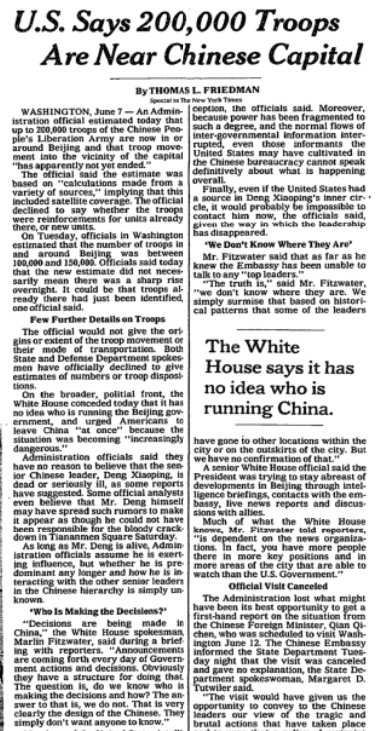
July 8, 1989 – In New York Times op-ed, Richard Holbrooke outlines four possible scenarios for China’s future.
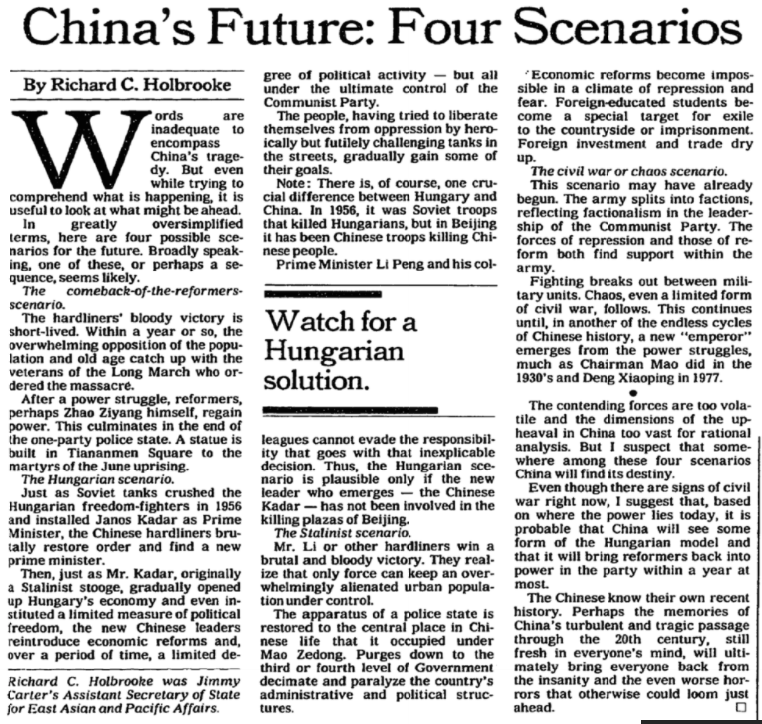
June 9, 1989 – Martial law troops begin cleaning up the damaged streets of Beijing.
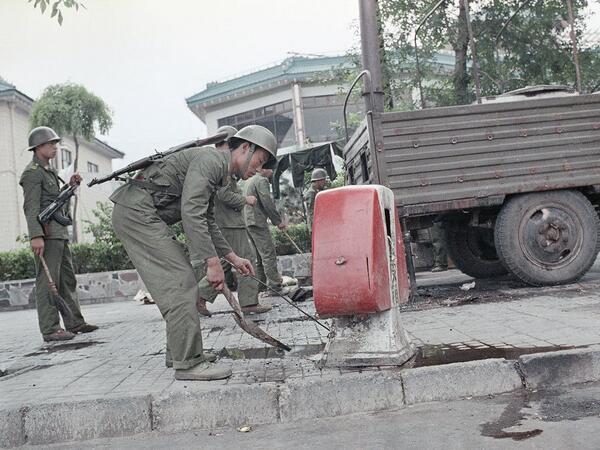
June 9, 1989 – New York Times: Li Peng makes public appearance; President Bush bars normal ties with China for now.
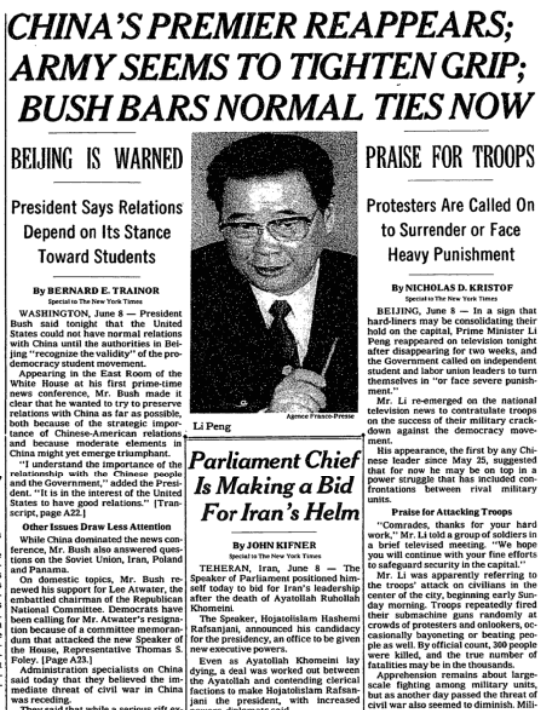
June 9, 1989 – Beijing residents read martial law announcements posted on the streets.
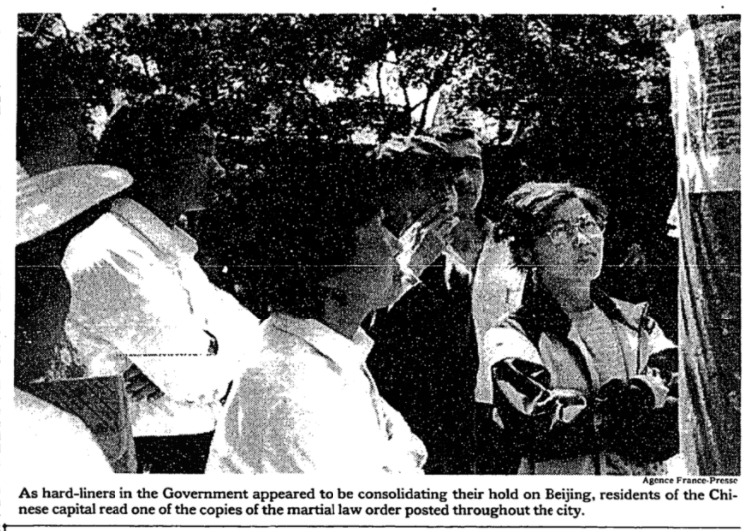
July 9, 1989 – New York Times: Heavy military occupation of Beijing continues.
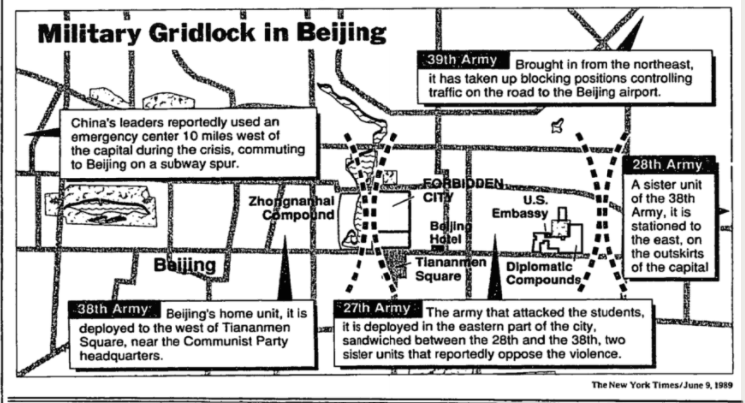
June 9, 1989 – 100,000 workers sent to clear roadblocks in Shanghai, while students conduct peaceful memorial protest.
July 9, 1989 – Soldiers camped on the main streets of Beijing wash their clothes.
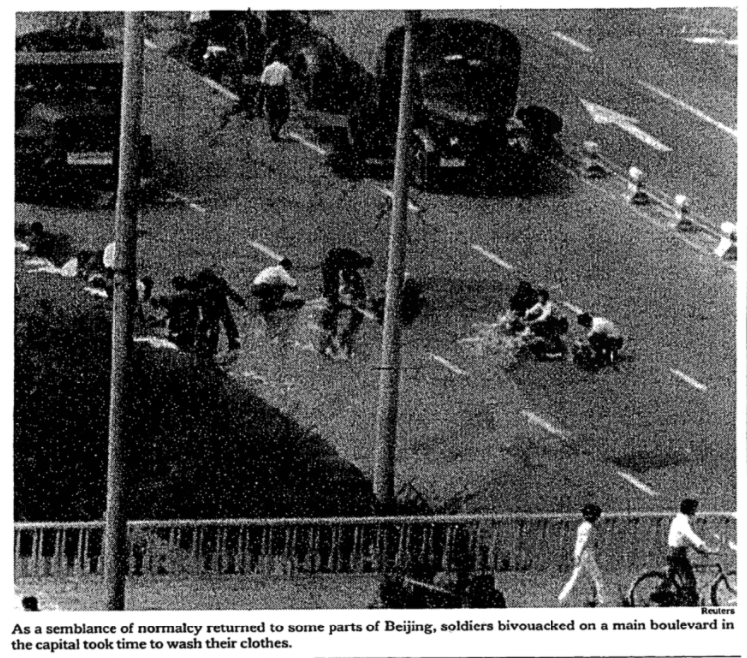
June 9, 1989 – Police lead away a protest organizer arrested in Beijing.
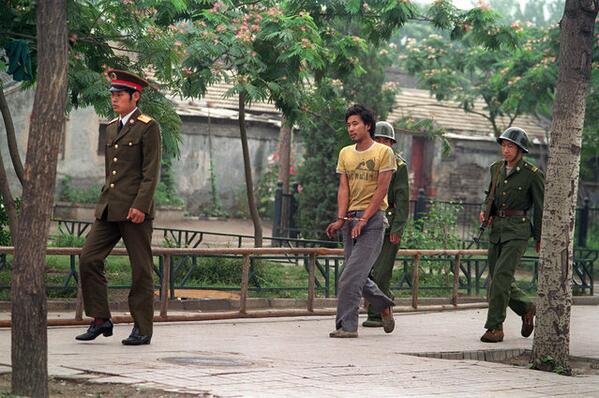
June 9, 1989 – New York Times: Voice of America beams TV signals into China.
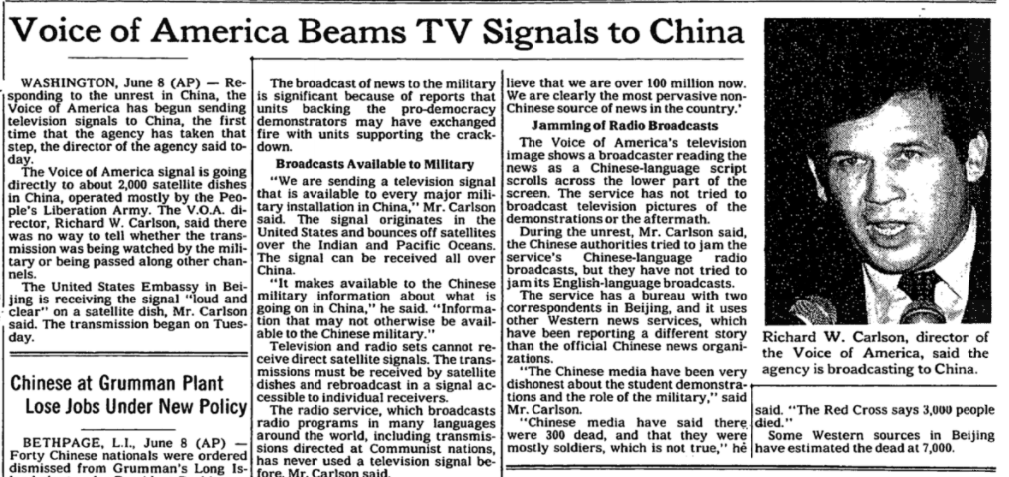
June 9, 1989 – Peaceful students protests continue in Xi’an, Lanzhou, Yinchuan, Hangzhou, Guiyang, and Guangzhou, but calm returning.
June 9, 1989 – Tens of thousands hold protest rally in Shanghai.
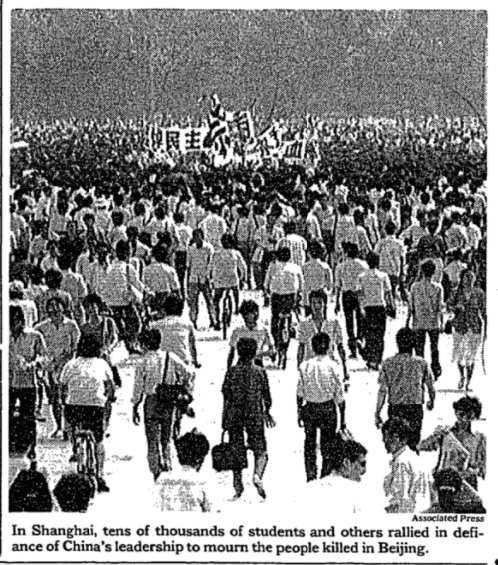
June 9, 1989 – Protesters in Shanghai defy government crackdown.
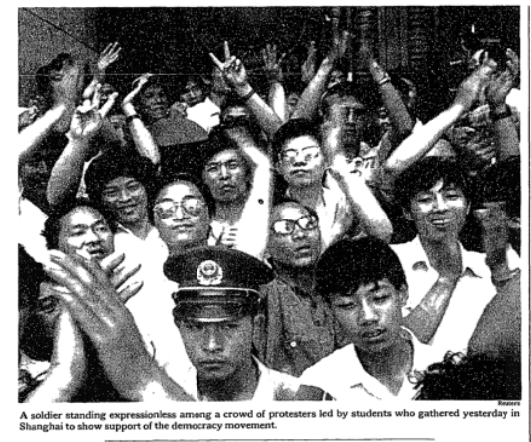
June 9, 1989 – Beijing under martial law: tanks and soldiers stand guard at Tiananmen.
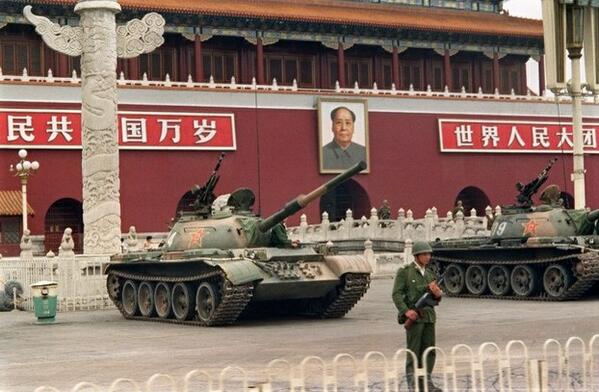
June 9, 1989 – New York Times: Evacuated Americans recount close calls.
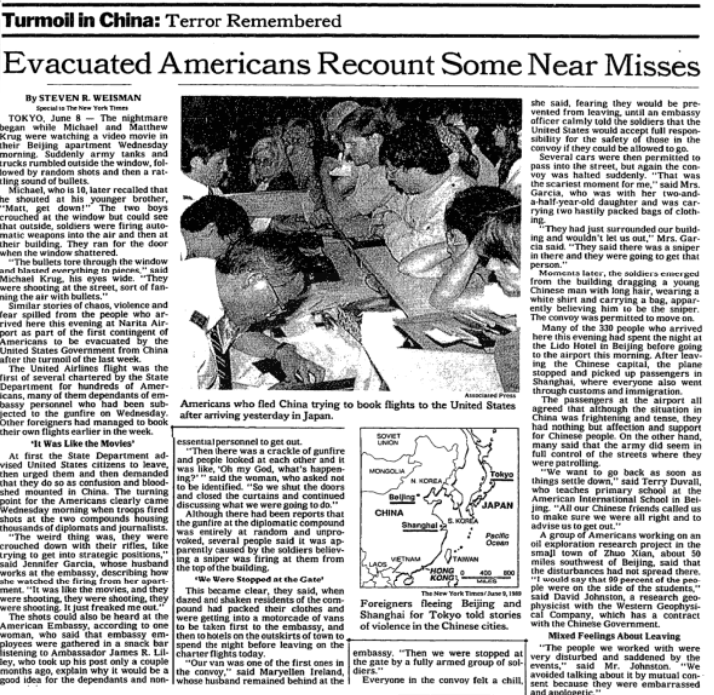
June 9, 1989 – Deng Xiaoping publicly congratulates commanders of martial law troops for mission accomplished.
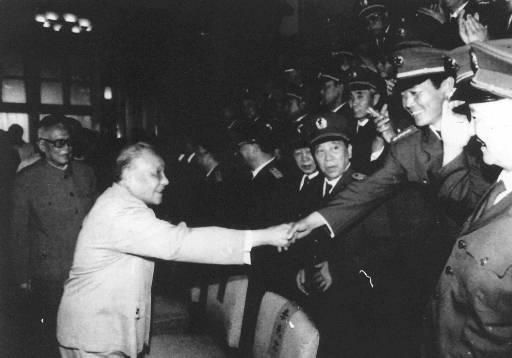
June 10, 1989 – Tanks, soldiers, barbed wire, and definitely no tourists at Beijing’s Gate of Heavenly Peace.
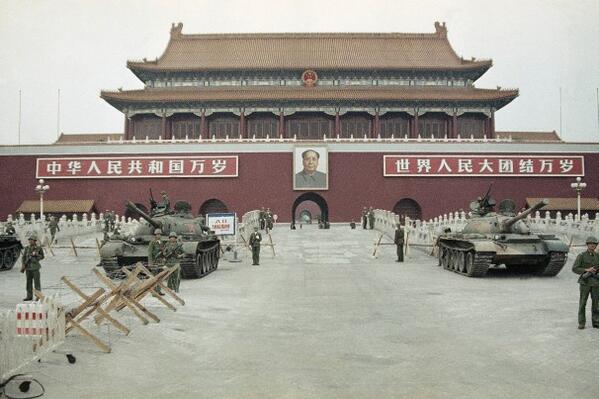
June 10, 1989 – Burned-out buses once used as barricades still litter the streets in downtown Beijing.
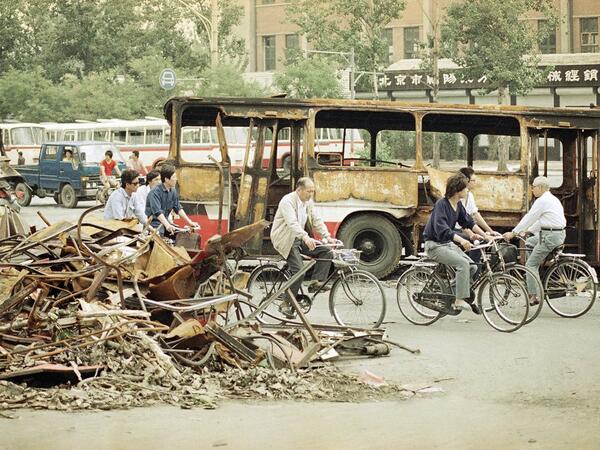
June 10, 1989 – Central orders go out to China’s provinces to immediately stifle any remaining student protests, peaceful or otherwise.
June 10, 1989 – New York Times: Chinese students in US continues protests, worry what awaits them when they return to China.
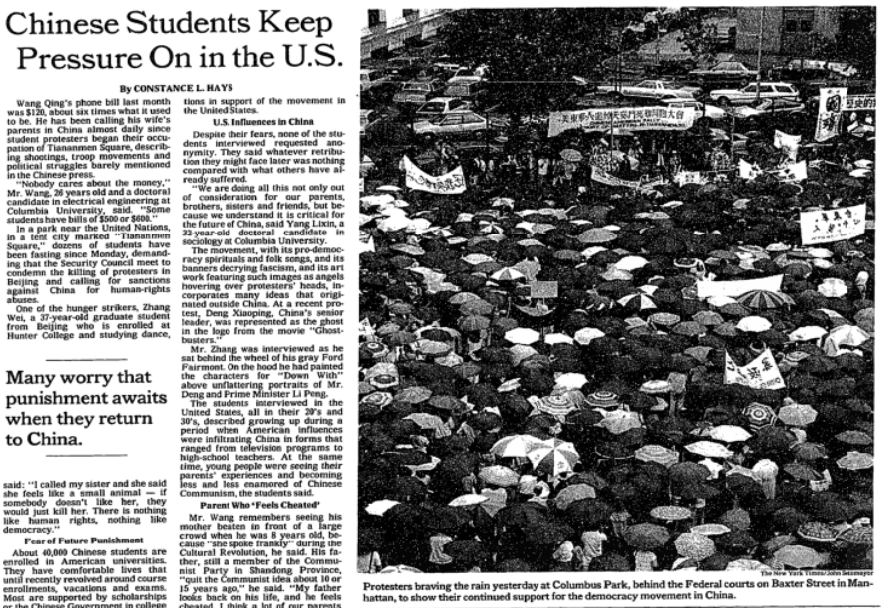
June 10, 1989 – New York Times: Rocky period lies ahead between US and China.
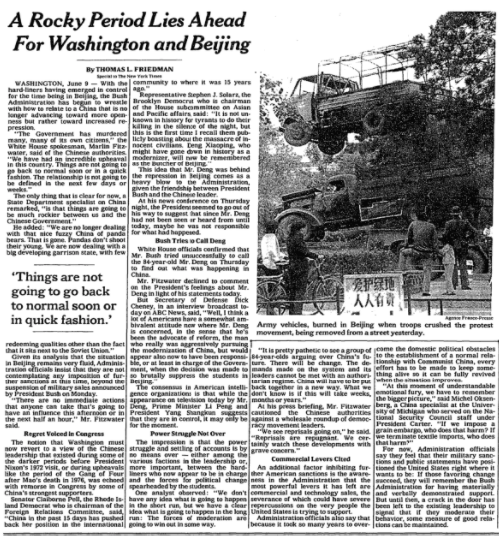
June 10, 1989 – New York Times: US-China relations appear badly damaged; some fear China will turn towards Russia.
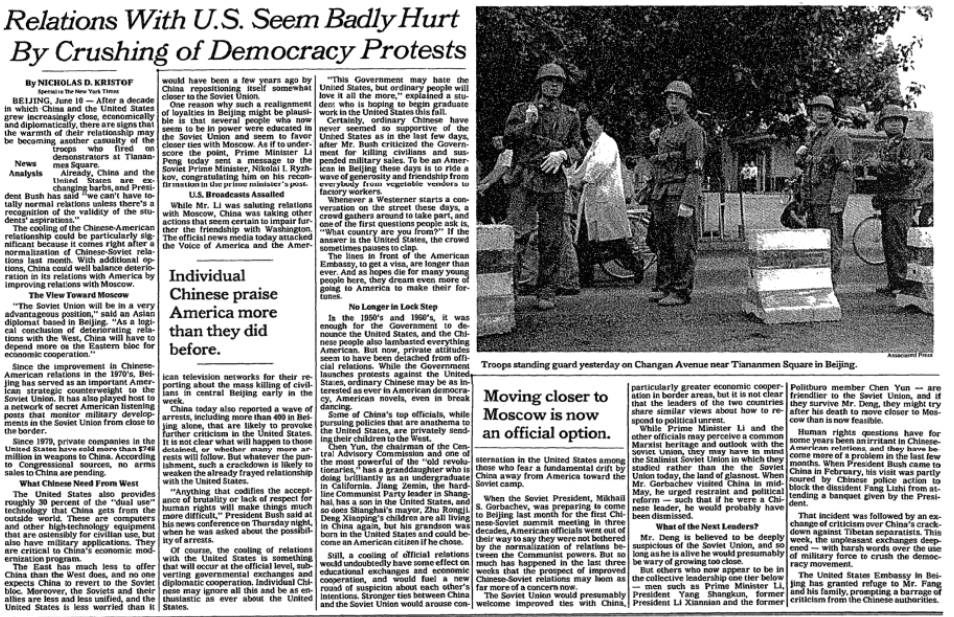
June 11, 1989 – New York Times: Dissidents arrested in Shanghai as protests continue.
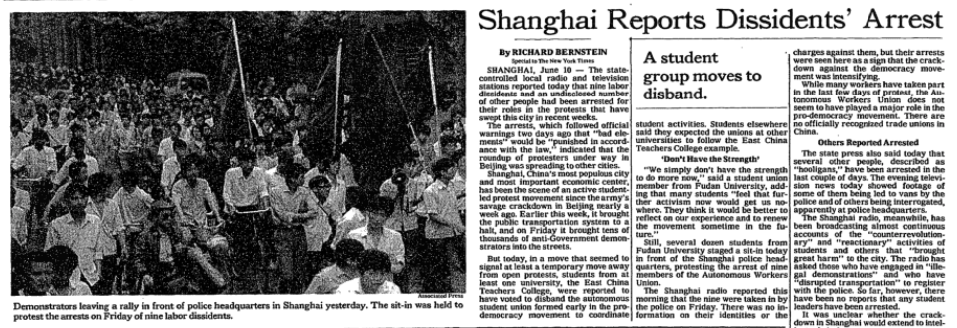
June 11, 1989 – Beijing under martial law: soldiers marching in Tiananmen Square.
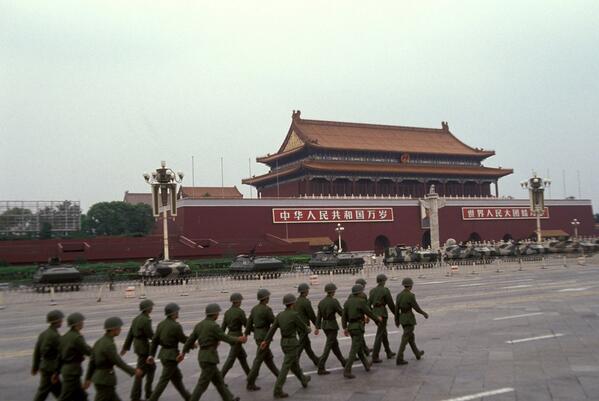
June 11, 1989 – New York Times: China arrests 400 in Beijing amid fears of a wide purge.
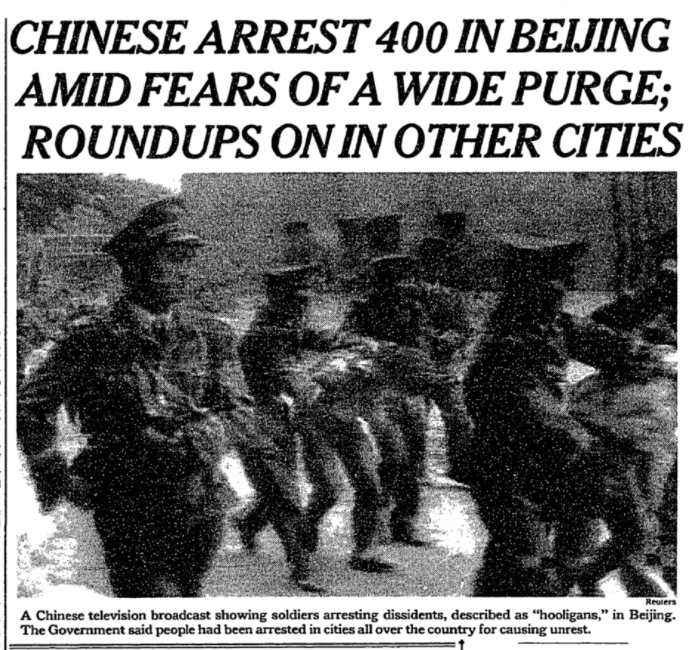
June 12, 1989 – Commuters pedal past tank and barbed wire on sidewalk in downtown Beijing.
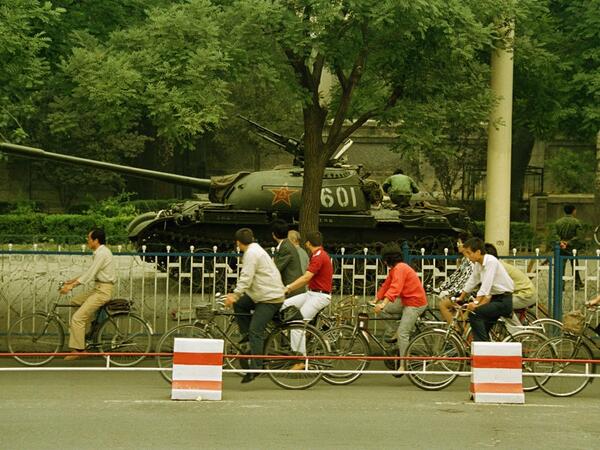
June 12, 1989 – Arrest warrant for Fang Lizhi and his wife (taken refuge in US embassy) is broadcast on China state TV.
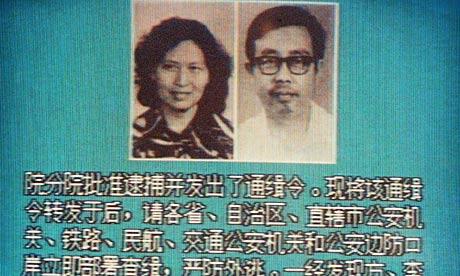
June 12, 1989 – New York Times: China seeks arrest of top dissident, moves to rewrite history.
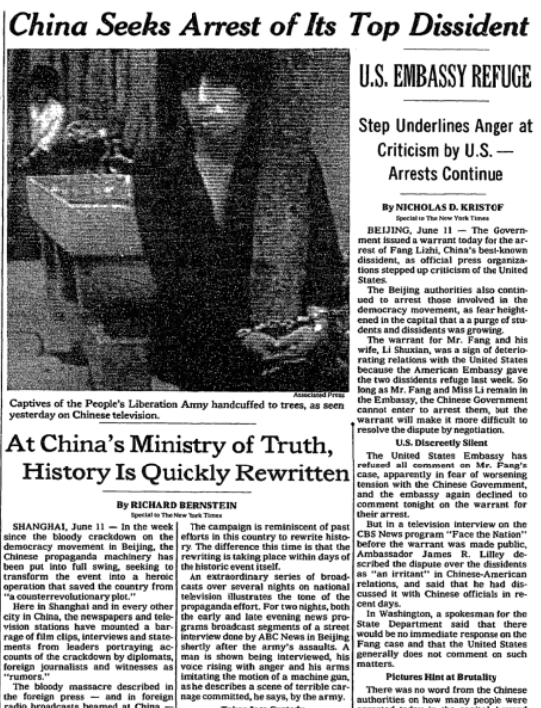
June 12, 1989 – Cover of TIME Magazine.
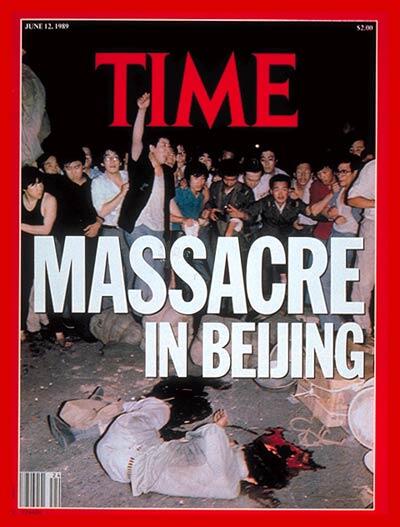
June 12, 1989 – New York Times: China’s democracy movement is over, for now. “Everyone is terrified into submission. Who can resist guns?”
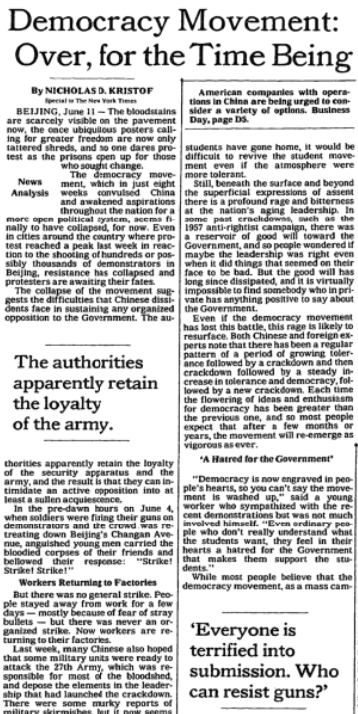
June 13, 1989 – Cyclists pass barbed wire and armored personnel carriers in front of Beijing’s Tiananmen.
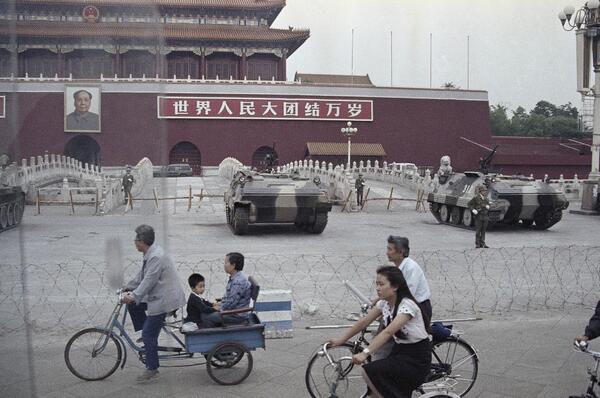
June 12, 1989 – New York Times: Public transportation in Shanghai, paralyzed by protests last week, has returned to normal.
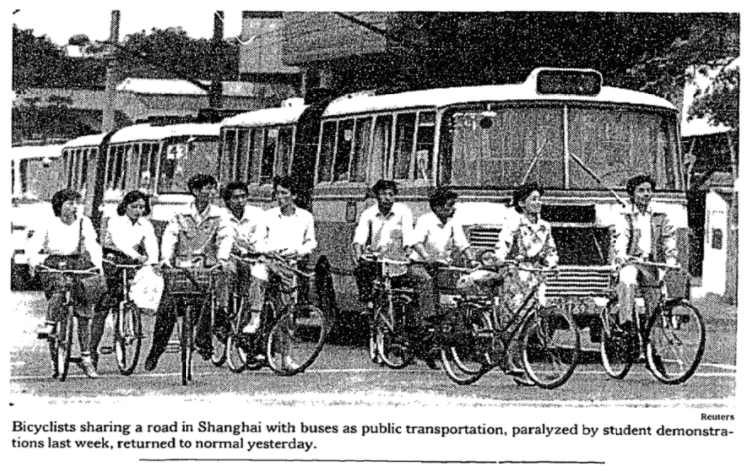
June 13, 1989 – Beijing commuters pass tanks deployed in Tiananmen Square.
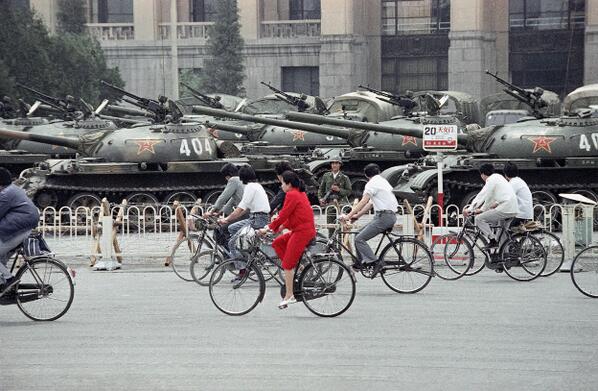
July 13, 1989 – New York Times: China bans groups calling for democracy.
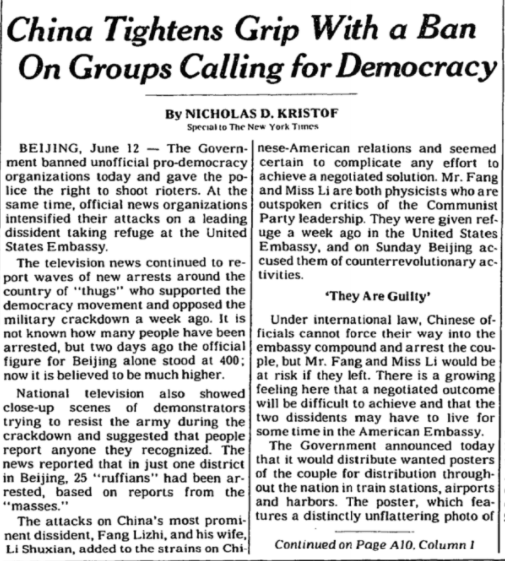
June 13, 1989 – Shanghai residents read statement by President Bush, posted outside the U.S. consulate, condemning the Chinese government’s crackdown.
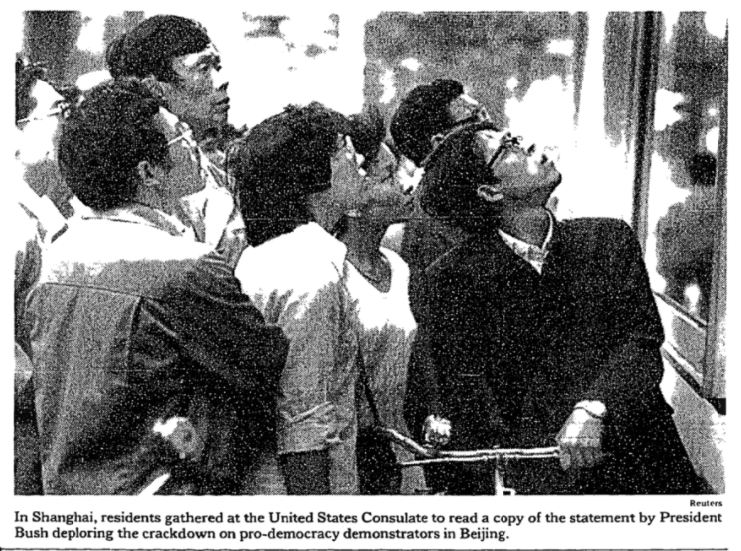
June 13, 1989 – Chinese government issues list of 21 “most wanted” instigators of the protests in Tiananmen Square.
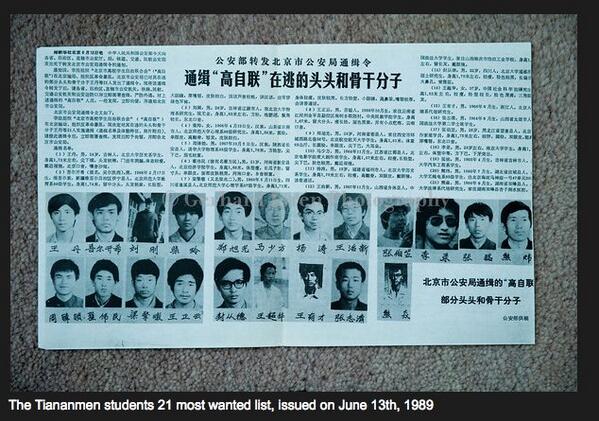
June 1989 – China’s now-First Lady Peng Liyuan (Xi Jinping’s wife)serenades martial law soldiers in Tiananmen Square. This photo was quickly scrubbed from China’s internet after it came to light in 2013.
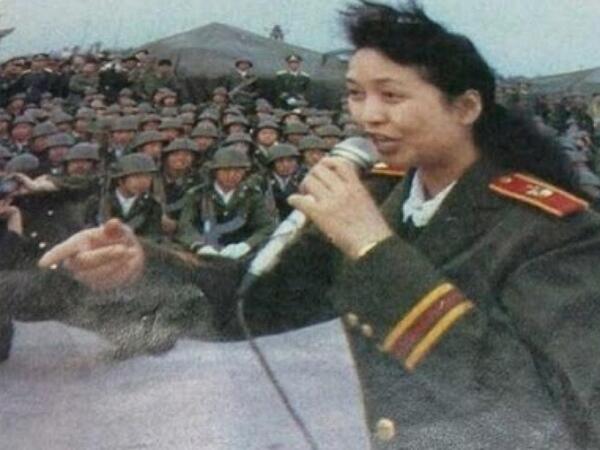
[…] The Square had been cleared of protesters, but the story was far from over. It continues here, in Part 5: Aftermath. […]